#because for something that's such a recurring theme in sculptures
Explore tagged Tumblr posts
Text
I have finally found a literary reference to Apollo riding griffins:
"When fair Apollo leaves Delphi's shrine and visits the altars of the north, Castalia's waters differ in no wise from those of any common stream, nor the laurel from any common tree; sad and silent is the cave and the shrine without a worshipper. But if Phoebus is there, Phoebus returned from Scythian climes to his Delphic tripod, guiding thither his yoked griffins, the woods, the caves regain their voice, the streams their life"
– Claudian, On the Sixth Consulship of the Emperor Honorius (trans. Maurice Platnauer)
Thank you Claudian, I shall cherish this.
#you don't understand how happy this made me#because for something that's such a recurring theme in sculptures#griffins barely appear as Apollo's animals in literature#griffins#mine
113 notes
·
View notes
Text
Human Nature Manifesto
We walk around daily and cross so many people that we will never remember. Regardless, people have so much in common regarding how we think, act, feel, love, etc. The theme I decided to base my manifesto on is human nature and the fact that although we are a small portion of an entire enlarged world, when we spread positivity and kindness, we aid in growing a brighter world. Doing this allows us to increase morals in human beings and helps assist in a more excellent human behavioral pattern in the future. To begin with my first Tumblr, I discussed how a podcast of two girls sharing their journey in faith impacted me. These two girls could've supported their religion and done it silently, but instead, they pushed their words for the greater good. Sharing their stories and journey in faith inspired numerous people to grow in their love for others and God.
The next Tumblr I created was on public art, the Caloosahatchee manuscripts. This sculpture is an identity of our town, and it catches the immediate attention of those who walk past it. The art of the object is lovely to the naked eye of any human who may come across it. This expresses human nature to those of us who walk by and appreciate the beauty of architecture. Allowing ourselves to value the good aspects of our lives helps us continue to see the great in the world. When we focus on harmful elements, we give ourselves no room to grow and appreciate what we have. The next Tumblr I created focused on domestic architecture. The places I had chosen for this topic were two familiar homes where my grandparents lived. What connects this to my theme is that people are very fortunate to call a place home and have family. I compared the two homes, and concluding my topic, I discussed how people make you feel at home, not necessarily just a place that may be capable of that. This allows us to experience human nature by loving and caring for our families, friends, and those who make us feel at home. Our next task for this course was to pick from various poetry and interpret it into a deeper meaning. I chose a poem named "Love and Friendship" by Emily Bronte.
To summarize, this poem discusses the importance of friendship and the fact that we should prioritize it like we would a lover. Loving our friends is an integral part of life, and being there for someone and having that reciprocated creates a better life for both of you. Having people you can count on and love unconditionally despite their flaws and faults helps us create a better world by building trust and relationships among others. The next assignment was to create a storyline. I did one on an imaginary scenario if a zombie apocalypse were to occur. Oddly, this scenario connects to my theme because in a case like this, I started talking about people coming together for survival. Nobody would want to experience something like this alone, proving we can accomplish so much more when we work together—working together creates a better outcome, increases personal growth, and improves efficiency and problem-solving. The next step in this course was to find a list of songs that follow a recurring theme. My theme was based on friendship. The songs I chose all had some connection to friendship and the beauty of it. We truthfully need each other in this world and are more satisfied with the quality of our lives when we develop beautiful connections with people. Finally, when doing my ekphrasis, I told the story of a girl in an art piece from a movie scene. In this piece, I specified the sentiment of the image, which is support and comfort. The father comforts the daughter, who appears to be stressed or overwhelmed— comforting someone when they are experiencing hardships in their lives helps them feel calm and allows them the room to express their feelings and face their problems with the help you can lend them. Human nature enables us to benefit from our characteristics and help shape a better society. It is phenomenal how we all don't know many of those around us, but somehow, we all work together with human nature to build a better world for everyone.
0 notes
Text
Places in London to visit that doesn’t feel like the Capital!

One of London’s best things is that it’s very diverse and doesn’t always look or feel like London. There are plenty of things to do and places in London to visit, but sometimes it can be overwhelming to pick out one particular place. When it comes to travelling in London, it’s easy to go about doing the same old routines and hanging out in our go-to spots. Whether it’s a night out with the girls at a groovy night club or chilling with the boys at a local pub, or strolling around the city with your significant other in usual comfort zones.
Yes, we as humans are creatures of habit, and tend to do the everyday, recurring things. But I think you’ll agree with me when I say that it is good to mix up things every now and then! Luckily, there are places in London to visit, which are full of surprises and fascinating escapes that will give your regular travel routine a good appal. And it’s bound to make you feel you’ve travelled miles away from the city. Here’s a list of unique places in London to visit that might not look or feel like it! Try something out of the box, something inspirational, and it can be in your own back yard!
Little Venice
Where are you? In Venice, Italy
Have you always wanted to visit Venice and take a romantic gondola ride, but never had the chance? Well, the good news is that you can have the same experience right at home in Little Venice! This lovely hidden gem and an eccentric area located in a suburban area of Maida Vale in North London. It is swarming with colourful houseboats and quaint cafes. Nestled between the Great Union Canal and Regent’s Canal. Little Venice is one of the most popular places in London to visit that will make you feel that you’re not in London! Take a boat trip in Little Venice as you cruise down the canal that mimics the Venetian lagoon and the romantic gondola ride.
Kew Gardens
Where are you? In Japan
My next choice is the Kew Gardens, the largest UNESCO World Heritage Site in London and the perfect escape from the city’s rush. The gardens are home to the most diverse collection of living plants globally, and it’s the perfect place for a day out. Discover beautiful Japanese sculpted landscape, the iconic Palm House and its exotic rainforest. I’m certain that a visit to this place will have you imagine that you’re on a getaway in Japan, finding your inner Zen in a peaceful setting.
Vertical Chill
Where are you? Climbing Mt. Everest
Feel like going on an extreme mountaineering experience, but you’re stuck in London? Don’t worry, there’s just the solution to your cold whim! Swap the icy climes of Mt. Everest for Covent Garden instead, where you’ll find, Vertical Chill an imposing tall wall of ice, just waiting to be conquered. It offers the same rush and all the exhilaration without the risk of frostbite and frozen meals.
Ruislip Lido
Where are you? In the Mediterranean
Out of the places in London to visit, Ruislip Lido is my absolute favourite! Well, maybe it’s because I love me some sunshine and this is the perfect place to soak in some rays! Okay, yes, I know that London’s sunshine is not as strong as the Mediterranean’s rays, but you can still find that quiet beach vibes. Ruislip Lido is a large lake surrounded by golden sand, making it a wonderful place for sunbathers, long walks and picnics.
Crystal Palace Park Dinosaur Sculptures
Where are you? In Indonesia
When you’re travelling in London, make sure to pay a visit to the Crystal Palace Park. This will be a superb activity for the kids! This park is a Victorian theme park located in south-east London. However, the park consists of 30 palaeontological statues, five geological displays, and Indo-like landscape. The not-so-accurate collection of concrete lizards are scattered around the park’s lakes, for kids of all ages to enjoy!
Leighton House Museum
Where are you? In Turkey
Yes! You’ll definitely have the Turkish vibes with its bold Middle-Eastern decor, and warm ambience. Leighton House Museum is named as the place ‘where east meets west’. It is located in the heart of Kensington, London. This was once a home of artist Frederic, Lord Leighton and is the product of an artistic vision that ran wild. The museum is filled with paintings of the artist. But it’s the ‘Arab Hall’ that’s the real deal, a large domed room covered in tiles and mosaics will make you forget which continent you’re in.
Shri Swaminarayan Mandir
Where are you? In India
Popularly known as the ‘Neasden Temple’, is a Hindu worship place located at a beautiful setting and is one of the biggest Hindu temples outside India. Shri Swaminarayan Mandir isn’t on every tourist’s ‘must-visit’ list but is one of the best places in London to visit. It was built out of Bulgarian limestone and Italian marble, carved by hand in India before assembling it in London. When you enter the temple, filled with beautiful carvings and shrines of Hindu deities, you’ll instantly feel you’re on Indian soil.
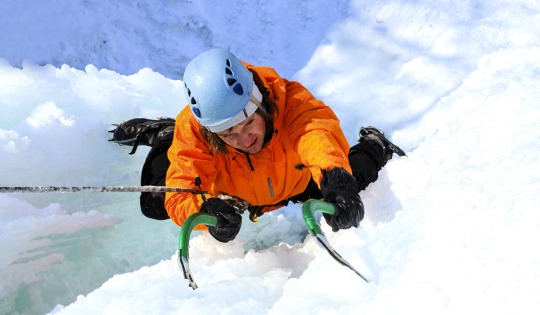


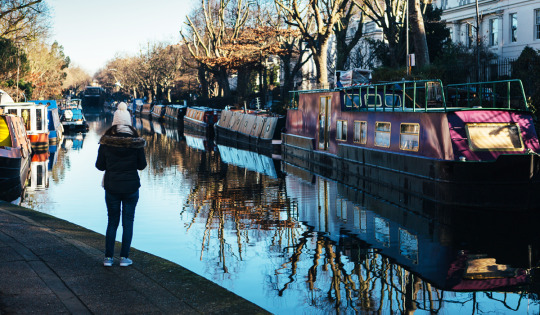

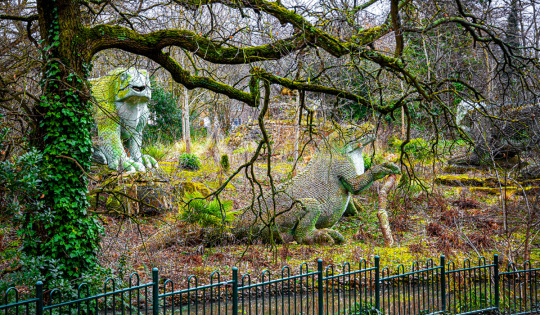
Best sightseeing spots when travelling in London
These locations below have become some of the unique places in London to visit famous for the most unusual views in the city. From marvellous architecture, street art to beautiful gardens. Not forgetting that these are some of the most Instagrammable spots in the Capital.
Frank’s Café, Peckham
Girl with A Dolphin, St. Katherine’s Docks
Churchill Arms, Kensington
The Sky Garden, Fenchurch Street
The Light-Up Tunnel, King’s Cross
Leake Street, Waterloo
The Great Hall at the British Museum, Holborn
The Staircase, Renaissance Hotel at St. Pancras
Baker Street Underground Station
The Cineworld at West India Quay
How many of these sightseeing spots in London have you seen? Let me know in the comments below!
Read More:- Places in London to visit that doesn’t feel like the Capital!
This Article, Information & Images Source (copyright):- Travel Center UK Blog
#london#travel#little venice#Kew Gardens#Vertical Chill#Ruislip Lido#Crystal Palace Park Dinosaur Sculptures#Leighton House Museum#Shri Swaminarayan Mandir
4 notes
·
View notes
Text
Rewatching WEP EP01
I was planning on rewatching Wonder Egg Priority anyway, but now that there’s an English dub that makes it even better! I’ve decided to make a list of things that I didn’t notice the first time around, things I’d forgotten about, or things that make more sense now in hindsight with knowledge from future episodes.

Acca and Ura-Acca both laugh when Ai says she doesn’t want anything, the first time she descends the stairs to the Egg room. As the lights go dark behind her, and the laughter overlaps, it comes across as quite creepy. Maybe a hint about the truth of the Accas and purpose of the Egg Dreams?

Acca gets very angry when Ai hesitates to break the first Egg (at least I’m pretty sure it was Acca’s voice speaking, not Ura-Accas). Another hint to Acca’s real intentions. I remember this crops up again in later episodes; Ura-Acca is more lenient with allowing the girls time to play while Acca just wants them to get back to hatching Eggs.
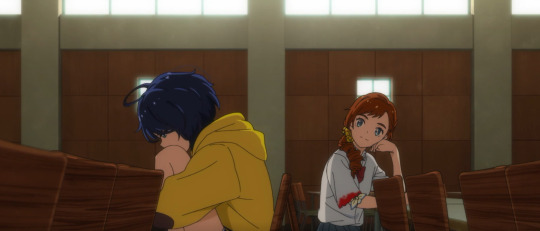
Kurumi sure does know a lot about the Wonder Egg situation. She knows about the Seeno Evils, that they’re only after her, that there’s a time limit, that Ai is immortal (as long as her eyes and heart are intact). We find out later that the Acca’s can control which Eggs the girls get, so did they pick Kurumi on purpose to be a tutorial for Ai? Do the Accas pick all the Eggs? Each girl tends to get Eggs that died by a common theme; Ai gets girls who where bullied (by a schoolmate, or their coach) Rika gets girls who were led to suicide by a popular figure (the Yu-Yu fangirls, the girl in the cult) Momoe gets girls who were sexually abused, Neiru...I’m not sure about Neiru. But either the Dream World works by this unsaid law, or the Accas are choosing Eggs of a certain type specifically for each girl.

All the other Wonder Killers we see are based on adults. They are outlandish, bizarre and brightly coloured. Except for Kurumis. Is it because this Wonder Killer is another young girl that she doesn’t look as strange as the others? Or did she just not have enough time to ‘evolve’ to that form, like the coach does in episode 2? It could be something to do with how children perceive adults who hurt them (as literal monsters), or it could tie into the recurring theme of girls dying young before they become ‘dirty’ adults (one of Neiru’s Egg Girls and Wonder Killer Sawaki reference this).

When Koito visits Ai at her house, we get a shot of a vase of lilies. Flower Language plays a huge part in this anime. Lilies can symbolize death (a funeral), innocence, purity, or it can be short-hand for yuri (girls love/lesbians). In my opinion this could be a reference to Koitos suicide, the innocence of their friendship, or hint that Koito was in love with Ai (or/and vice versa) rather than Sawaki-Sensei (the fact the vase is in the dark could mean something too).
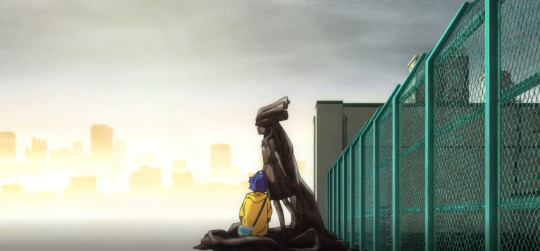
“It’s all my fault, because I betrayed you”. Ai says this to Koito’s statue. This could be referencing that Ai did nothing to stop Koito’s bullies or (if the penultimate episode can be taken at face value) that Ai was supposed to jump with Koito but backed out at the last minute. However this would contradict a later episode where Ai seems to say that she would have died with Koito, if Koito had asked her.

“If I save more people, then won’t Koito come back? Tell me she will!” So far in this episode I think the Accas have only stated that the statue girls “will be saved”. I’ll have to see in future episodes do the Accas ever confirm that the statue girls will come back to life, or if this is something Ai and her friends only assume to be the case.
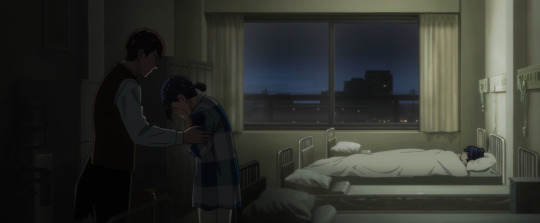
I did NOT catch this the first time (I think I assumed it was a doctor and then forgot about it) but the man with Ai’s mom in the hospital is Sawaki Sensei. So they were already that close, that she called on him for emotional support.
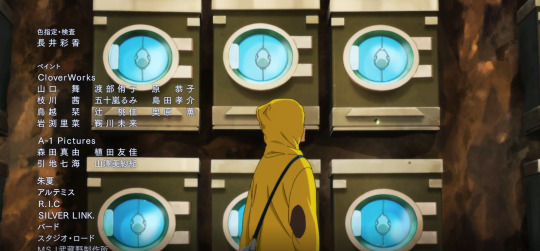
The Accas say that Kurumi is “a sculpture in some other world”. So there was a hint as early as episode 1 that there are parallel worlds! “And unless her friends go to that world, it’s likely she’ll stay that way forever.” I thought only girls who had someone missing them became statues...but does this line mean that ALL girls who commit suicide become statues in the Dream World? Kurumi said that she only had fake/shallow friends, but I thought if she was a statue then someone missed her enough to want to bring her back. Maybe she’s so knowledgeable because she’s been hatched so many times, but is no closer to being saved because no friend is fighting for her... so she’s trapped in a constant cycle of being hatched.

Saw a lot of wisteria hanging over the entrance to the Accas house, so did a quick google search and: “Historically, Wisteria symbolizes long-life and immortality. ... In Japanese Kabuki theater, the symbolism for the Wisteria is Love, Sensuality, Support, Sensitivity, Bliss and Tenderness. The abundance of the Wisteria flowering vine also signifies our own expanding consciousness.” Immortality and expanding consciousness sounds about right...
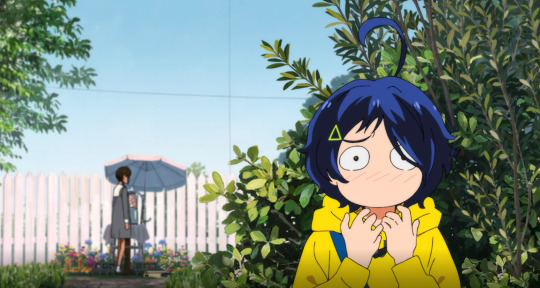
The Acca’s say they worry about Neiru, so apparently she’s been hatching Eggs for a while. I’m inclined to believe she’s been doing this longer than any of the others and with the most Eggs too, as she bulk buys enough Eggs to fills a suitcase. Yet, as far as we know, she’s the last girl of the four who hasn’t had her statue revive. We haven’t even seen her sister.
I thought I’d also point out the lines on the sky in the background (I’ve noticed them before, but it took me an embarrassingly long time, I think I only noticed the lines at all in Frills episode or around then) . Anyway, it’s a reminder that wherever the Accas are, it’s probably underground, fake and simulated, like their mannequin bodies. (I’ve never quite understood if the Accas and their house and Egg Gacha machine are in the real world or in a Dream....
A question I’ve wondered about before, but just remembered; how did the Accas find the girls in the first place?? How did they know where to find Ai and the others?
Can Egg girls be hatched in the same Dream that their statue resides in?
I just found out on the Acca’s wikipedia pages that Acca means ‘Red’ and Ura-Acca means ‘Reverse Acca’ or I suppose ‘Reverse Red’ (is ‘reverse red’ blue? Still the implications of ‘reverse’ are interesting).
1 note
·
View note
Text
Edwina Ashton
I'm initially drawn to Ashton's work because of her creation of anthropomorphic characters, in costume and sculpture. Her interpretation of human experience, emotion and relationships through these odd little creatures is much more appealing to me than presenting these things through a human mediator. There is a recurring theme of loneliness in Ashton's sculptures; even though they are arranged in groups the little people are facing away from one another and separate. The flimsy materiality of the characters lends itself to the narratives of everyday mistakes and awkwardness Ashton makes her performances and sculptures surrounding. There are recurring slapstick moments and 'bad gags', and the spaces created for the characters to inhabit are complementary in their haphazardness. Altogether, the scenes are poignant in their sorrowful emotion and allude to a very specific type of feeling.
This world of accidental animals is very unique, often existing in a puddle of pipe runoff, or around a form of scaffolding. The state of melancholy is understated, feeling like a backdrop for the scenes rather than the cause of them. They are very well rounded depictions of life, not steered by one aspect.
After seeing Ashwin's work, I'm toying with the idea of bringing more fragility and subtly to my world. In my head at the moment it's a bizarre landscape, but emotional vulnerability and respect of the vulnerable is something I think is important to attribute to my characters and how I present them. I've spent a bit of time picking together bits of lifestyles, interests and habits that give my characters unique world views, but I think I've been neglecting their emotions.
I think a way to create believable emotional tapestries for my characters is to interview real people who I think could have common ground.
I would also like to think about the activities i present my characters doing.










1 note
·
View note
Text
Sola Gratia (9/?)
Masterlist
Rating / Warnings : General audiences, no particular warnings.
Fandom : Bram Stoker’s Dracula, BBC’s Dracula, various Dracula and vampire lore.
Part 9/? (2000 words)
Author’s notes : I’m trying to get the chapters a more consistent length, I think 2000-2500 is good ! Means I’ll be able to work more consistently, but please don’t hesitate to tell me what you think about it ! Also, sorry for all the build-up, but a girl’s gotta set the decor a bit !
~ - ~ - ~ - ~ - ~ - ~ - ~ - ~ - ~ - ~ - ~ - ~
During the following weeks, the presence of the Count became almost familiar. Every day, he waited for me with a different kind of pastry. I tried to protest at first, but quickly had to make my peace with it. At some point, seeing me wince at my terrible coffee, he forbade me to drink it anymore, and added that to my daily breakfast. I asked him exactly once why he insisted on feeding me, to which he replied that he liked my blood healthy, with a toothy grin. I hit him over the arm, he laughed. Other than that, he was careful not to step over my boundaries, and seemed to find the way to only be there at the appropriate time.
That was not the case for Leah, however, who was delighted to see Vlad was going to be a recurring presence in our lives. The two of them got along far better than I would have wanted. Vlad especially enjoyed playing along with her when she started asking probing questions about the both of us, although I had to admit he was an expert at deviating any question that could have revealed his true nature.
It took me some time to fully realize how much he had actually seen, and lived. He died around the 1470s, which meant he had all the time in the world to see the Sistine Chapel being painted, the construction of the Eiffel Tower, or the damn french Revolution. He could have just been a very polyvalent historian, which is what I told Leah. She interpreted that as a challenge, considering he and I were, as she put it, “introverted nerds who need to see the light of the sun once in a goddamn while”. She started dragging us along in random activities. There was a pottery class, to which I was barely able to make the Leaning Flower Pot Of Pisa, while she somehow made an incredible owl sculpture, and Vlad had made a delicate greek-inspired vase. Seeing him, sleeves rolled up over his elbows, hair tied up in a ponytail, his long fingers working in precise, expert gestures, probably had noting to do with my absolute failure to make anything correct. I decided then that manual activities were a no-go for me in the car ride, where I sulked on the backseat, while Leah and Vlad were still crying-laughing about my sorry excuse for a pot.
After the rousing success of that experience, she wasn't about to stop. We did a haunted castle themed escape game, which Vlad curiously sucked at. That would explain some stuff. Leah then found out that a Renaissance faire was taking place in a small town, about an hour or two outside the city, and decided we definitely had to go. I tried to pretend I had too much work and wouldn't be able to make it, but Vlad and her insisting, I caved, and marked down my calendar with the red pen of defeat.
Being stuck in period costumes with the both of them wasn't the only reason I tried protesting. Laurent really did throw a ton of work on my shoulders, and that wasn't considering the whole Stephan Helder situation. The kid was highly motivated, sure, but he started making me feel uneasy, for some reason. After all my classes, he came to chat, and always found a way to ask questions about Vlad. Strangely phrased questions, or about how he couldn't find publications under his name. Legitimate questions, to be fair, but his insistence was bugging me.
“I'm telling you, that is weird. Those are weird questions”, I told Vlad, sitting on my windowsill. He didn't react. “I am serious, what if he knew ?”
“How would he know ?”, he sighed. “Why would he even want to know ?”
“Well, that's a fair question. Which needs an answer, don't you think ?”
He tilted his head, softly smiling. “I think you are being a bit paranoid.”
“I spend most of my free time hanging out with an immortal murder-machine, I think I deserve the right to be a bit paranoid”, I snapped.
“Fair enough”, he laughed.
Being immortal had to have dulled his sense of danger. Although, I could see how a skinny 20-year-old medieval history student wouldn't spontaneously raise red flags.
“By the way, I am going back to Romania”, he told me.
I felt a small pinch to my heart. “Oh.”
“Only for a few days”, he completed with a smirk. “I have to pick up some things, and oversee the moving company. I do not trust them with half my things.”
I furrowed my brow. “Moving company ?”
“Oh, did I not mention it ?”, he innocently replied. “Before I even arrived, I bought a little something a little ways outside the city. The renovations are done, and you of all people understand I cannot live there without a decent library.”
I took a second to process it. He had a smug look, obviously enjoying my confusion. I had to say I didn't even think about where he spent his nights. I figured he either turned into a bat and hanged somewhere upside down, or simply didn't sleep. Did he even need to rest ? Gods, so many questions I didn't even think to ask. Every day, I felt like I discovered a puddle, only to realize it was part of a lake.
“When I come back, would you come visit ?”, he asked, sounding a bit hesitant.
“Sure. I mean, as long as I don't have to wear heels if you decide to go feral on me.”
He took a dead-serious expression. “I promise you, Eris Cetero, that as long as you live, I will never, ever, make you wear heels again.”
I threw my head back with a groan of agony. Was it so bad that this kind of humor was actually funny to me now ? Was having a six century old bloodthirsty creature imply he might try to murder me again really that hilarious ? Apparently so, as I was unable to contain a giggle. Maybe it was because the look he had was all but threatening. Maybe because every time I was near him, even with all that happened, I felt... Safe. For a few weeks, I had been able to decide staying over at the University library until ungodly hours. I didn't have to thing about what time I had to leave at before it became too risky for a woman with very limited knowledge of martial arts, alone.
I mean, he was arguably more dangerous than any encounter I might have had, but still... I knew he wouldn't hurt me. Maybe it was wishful thinking. Then again, he had plenty of occasions to lose it. Last week, for instance, I had no idea what to expect when I left my apartment, dosed with painkillers, as Mother Nature, that ruthless bitch, decided to drop by for her monthly visit. He was simply waiting for me at the usual spot, looking a bit off, but holding a large box of chocolates along with my breakfast. He made himself scarce for the following three days, but I could tell he tried to act natural.
“I should let you get some rest”, Vlad told me, dragging me out of my thoughts.
I nodded, slowly. “When are you leaving ?”
“Some time tomorrow. I will still pick you up, if that is what worries you.”
He smiled, teasing. “Yeah, that's... That's it. I'd miss my personal chauffeur.” I looked away a second. “Now, get off my window, I need to sleep.”
“Of course, my Lady”, he replied, and backed away with an overly low bow. “I bid you good night.”
Once again, with a fluttering sound, the usual bat replaced the tall man. I called out to him, offering my hand as a perch. The tiny black creature gripped a finger. I would have expected a Vampire Bat, to be fair, and almost laughed when I realized it was a common little brown bat, only changing in the darker color.
“Well, don't you look adorable”, I told him.
I could take a more frightening appearance, if you want me to.
“Telepathy, huh ? That's new”, I commented. Nothing surprised me that much anymore, to be honest.
I try not to pry, it's usually considered rude.
“You don't say.”
He stretched out his wings. They were so thin I could see the tiny veins running across the membrane. I had to use all my will not to just scoop him up and pet his tiny head, or scratch his belly. Now, that would have been rude. Probably. Those kind of reflexions were a bit new to me.
I would stay here all night if I could, but I am starting to feel a bit hungry.
“Oh, by all means. I won't keep you.”
I heard a small squeaky sound I interpreted as a laugh, and he left. I closed the window, and the quiet made me rethink the situation. If he was gone, that would leave me some time to look into the Helder situation without him interfering. Now, I just needed the help of my favorite professional stalker. With a little smile, I slipped under my covers, and almost instantly faded into sleep.
~ ~ ~
After Vlad let me off at the University, he only came over to say hi to Leah, and announce his departure. He left right after, with a kiss for her hand, and one for my forehead.
“Do you need some ice ? You look pretty hot”, she snarked at me once he was gone. “A cold shower, perhaps ?”
“Oh, shut up, will you ?”, I groaned, placing the back of my hands onto my cheeks.
She snickered. She was the best friend I could ever hope to have, but man, as soon as someone was involved, she became absolutely unbearable.
“By the way, I need your help with something”, I told her, lowering my voice a little.
“Oooh, sneaky voice, I like it already. Tell me.”
I brought her inside, and we went straight to my office, a small, cluttered room in the old building. I dragged a folding chair next to mine, behind the heavy wooden desk.
“I'm having a weird feeling about a transfer student”, I told her. “I wondered if you could-”
Before I could even finish my sentence, she had already taken out her laptop, her glasses sitting on her nose. She turned on a bunch of apps she left running in the background, and turned to me.
“Name ?”
“Stephan Helder, with 'ph'”, I told her.
I kind of felt bad about it. If it was nothing, I was just prying into his personal life – or having Leah pry, anyway. She began typing away, and in less than three minutes, she had results. Stephan Jonathan Helder, 18, your typical genius type. Skipped a few middle-school classes, finished high-school at 15, with straight-As. Spotless criminal record, less so for the medical one, with a few bad cases of pulmonary infections. Didn't have one in years, though. Seemed like he was from a good family, but then again, no information on them showed up. Huh. I asked Leah to look into them.
“That's crazy”, she said after a good five minutes. “I mean, there's barely anything.”
“You mean he's an orphan, or something ?”
“No, it's just blacked out. I mean, most of the stuff has been scraped, erased.”
She sounded annoyed, but also excited. I knew she loved a challenge.
“Nothing I can't break”, she commented, and went back to it.
After a few more minutes, she finally had a triumphal shout.
“Got 'em”, she told me. “Stephan Jonathan Helder, the father is Thomas Mark Helder, and the mother is Mary... Huh. That's a cool name.”
“What is ?”, I asked, leaning over her shoulder to read.
My blood froze in my veins instantly.
Mary Van Helsing.
~ - ~ - ~ - ~ - ~ - ~ - ~ - ~ - ~ - ~ - ~ - ~
Taglist : @carydorse @angelicdestieldemon @bloodhon3yx @thewondernanazombie @battocar @moony691 @mjlock @thebeautyofdisorder @festering-queen @paracosmfantasy
#Sola Gratia#Sola Gratia part 9#fanfiction#fanfic#dracula fanfic#dracula castlevania#dracula bbc#dracula bram stoker#dracula#vlad tepes#romance#enemies to friends to lovers#enemies to lovers#vampire#vampire x human#dracula x human#dracula x reader#dracula x oc#slow burn
40 notes
·
View notes
Text
How to Make Underswap Sans: Antidepressants?
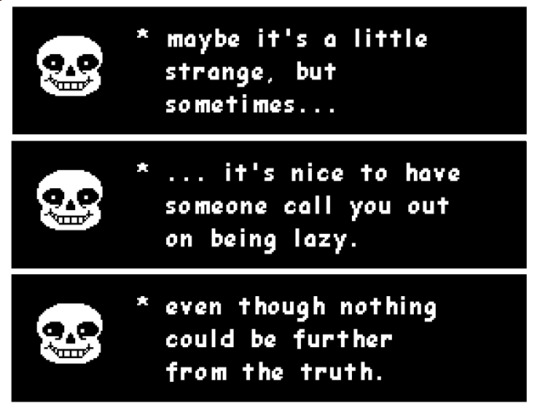
Author Patreon - Author Ko-Fi
Sans is a disproportionately popular Undertale character: many Alternate Universe (AU) fanworks focus on Sans, to the point some fanworks’ only character is a version of Sans. But what defines Sans as Sans?
The poll on the subject says that the following traits, if removed, would make Sans not be himself. The top three, in bold, have an 11% vote, while the others have a 9% or 8% vote.
• Makes jokes/puns
• Close bond with Papyrus
• Is lazy
• Keeps boosting his brother
• Papyrus existing
• Secretly powerful
• Sleeps a lot
• Lies to people/trolls people (e.g., selling "fried snow")
Some of Sans’ defining traits are conditional, subjective, or infrequent. For example, Sans may be powerful, but he’s secretly powerful: he only shows how strong he is in the Genocide Route, when he’s at his most desperate and despairing.
Sans’ laziness is an especially consistent, important, and complicated trait. Even in the Genocide Route battle, when he actually puts in some effort, much of his damage is dealt passively through the poison-like KR damage. There are multiple explanations for why he sleeps and slacks off so much: he might be nocturnal, spend many hours in his secret workshop at night, or his sentry jobs are simply so boring he has nothing better to do than nap.
However, Papyrus’s dialogue suggests something else:
Papyrus: HE'S GOTTEN REALLY OUT OF SHAPE. HE TIRES EASILY. LATELY HE'S BEEN NAPPING OVER 7 HOURS A NIGHT... HE'S NAPPING HIMSELF INTO AN EARLY GRAVE!! (Near Sans' first Hotland station, Papyrus phone call)
Papyrus’ dialogue suggests Sans’ traits of slowness, weakness, tiredness and excessive sleeping are recent developments. Undyne’s statement on Sans making "100's [sic] of midnight snacks" might mean he has insomnia or irregular eating patterns, too.
While his knowledge of individual resets seems limited to feelings of deja vu and his improbable face-reading abilities, Sans is aware resets are happening. Thus, some figure Sans’ helplessness facing a time-warper in the Flowey Runs, and the pointlessness of doing anything when time is going to be reset, is responsible for Sans’ behavioral changes.
In fact, some fans suggest the Flowey Runs gave him depression.
Depression
Given his symptoms, this is a plausible idea. Sans sleeping and slacking off a lot, his (possible) lack of hygiene, and putting low effort in snow sculptures, puzzles, and room-cleaning are all aspects of his “laziness”, but also parallel the behavior of depressed people. Depressed people have little motivation or energy, so, rather than being “lazy”, Sans may lack the resources to do non-critical tasks.
On a weaker note, Sans’ recurring, light-hearted punning and jokes could be a symptom of his depression, a happy mask to prevent anyone worrying about him. After all, depressed people may use humor to deal with their illness, and it’s well-known good comedians often have mental illness.
Some fans even suppose Sans’ low stats are caused by him having depression, based off the Snowdin library books saying “If a monster doesn't want to fight, its defenses will weaken” and “Because they are made of magic, monsters’ bodies are attuned to their SOUL”. If true, that would link yet another distinctive trait to depression. Yet, if Sans only got depression recently, then his humor attempts, low stats, and “laziness” may not be true facets of his personality. However, the poll shows that if these traits were taken away, he wouldn’t be himself. If Sans indeed has depression, then would taking magic antidepressants make him not Sans?
Recognizability and AU Sanses
Sans himself might still feel a continuity of identity between a possibly-depressed state and a recovered state. After all, some people figure their depression is part of their personality, and others do not. However, a non-depressed Sans might not be recognizable to the Player or Frisk.
One problem with guessing Sans’ “true” personality (or how he used to be before the Flowey Runs) is that Undertale players only know Sans as he exists within roughly one day. For example, Sans could, unbeknownst to Papyrus, work out every Wednesday, but people wouldn’t know about this if the game took place on a Tuesday. Sans could have had ambitions, a la Papyrus, before meeting Frisk: there’s no way of knowing. Perhaps he still joked, but his jokes were better. (Papyrus puns a lot himself, so he seems to groan at Sans’ puns because they are bad puns.)
Before developing depression, he could have been more active and slept less, and the same could happen in reverse if his depression abates. Overall, he might have been somewhat closer to the energetic and purposeful Papyrus...or, in other words, like Underswap Sans. Though Underswap Sans is often portrayed as “Papyrus’ mind in Sans’ body”, transplanting all of Papyrus’s traits is likely unnecessary to make an energetic and purposeful version of Sans.
Related Reading
Flowey and PTSD (Warning: Severe mental illness and trauma) Papyrus is (Probably) A Better Boyfriend than Sans (Character Analysis with the theme of an ideal boyfriend) Undyne’s Prejudice (Character analysis of one aspect of a character’s personality)
53 notes
·
View notes
Photo

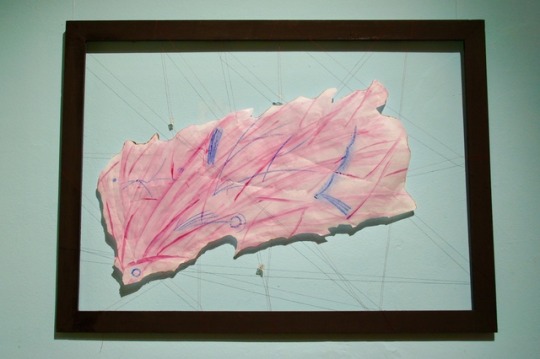
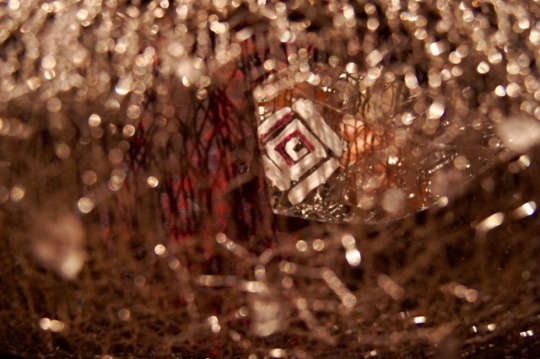
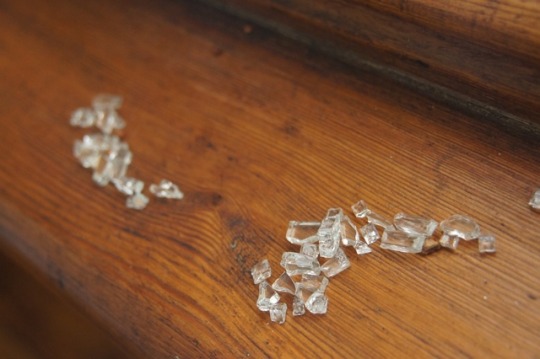
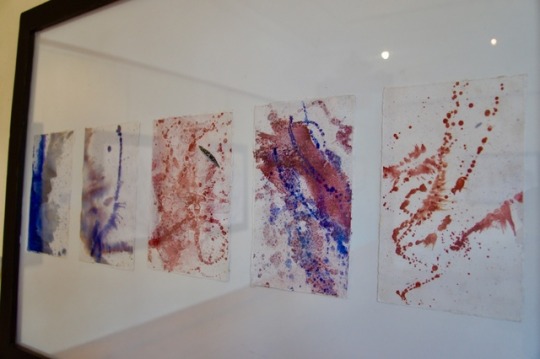
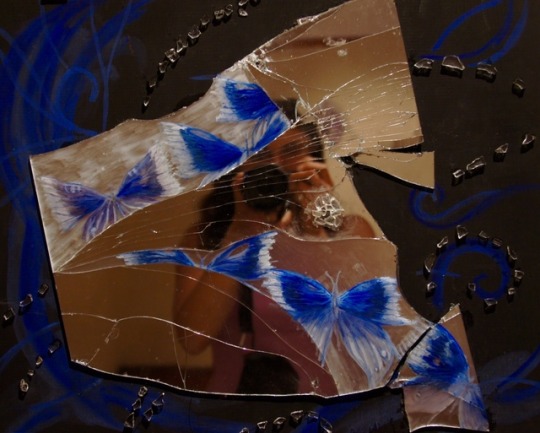
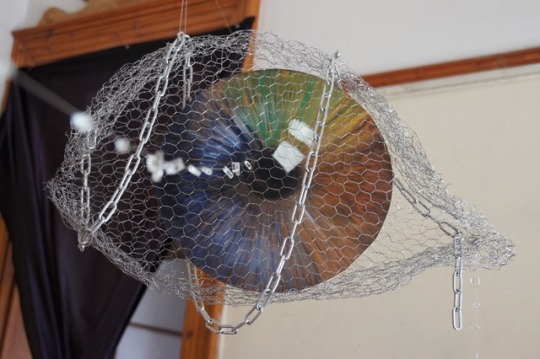
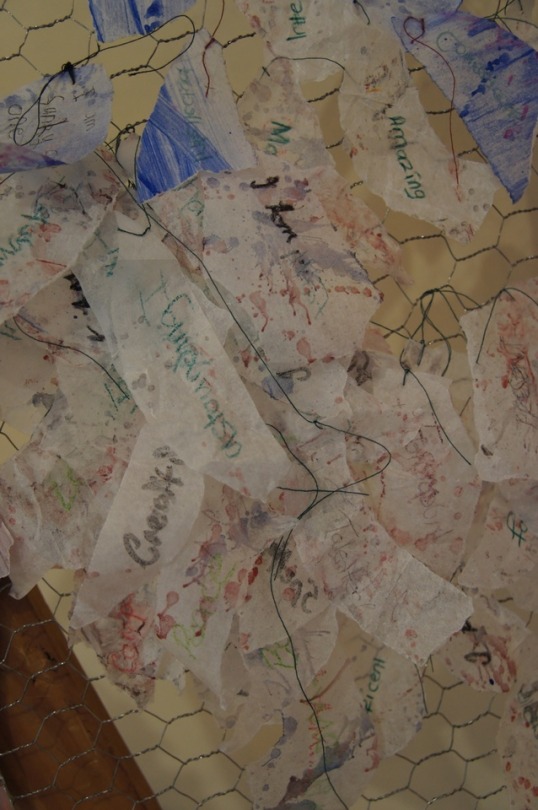
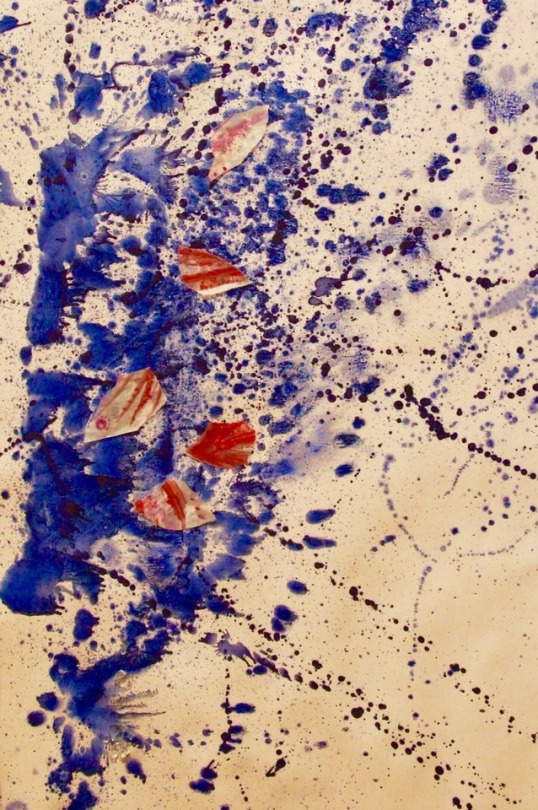
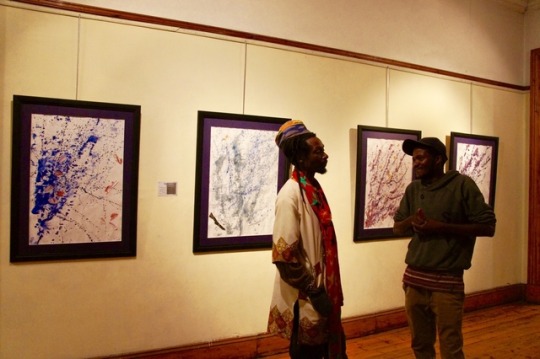
‘Emergence’ National Gallery of Zimbabwe, Bulawayo September 6th - 19th October 2019 A few pics that I’ve finally managed to upload and a summary of my processes and review of the show and how I felt it went. In my usual way, fairly personal in places. I wrote it immediately after the show and views are always going to change within time. It’s been a few weeks now and I’ve made the transition from Zimbabwe to Botswana, I’ve had time to recover and chill for a little while. Not much drawing going on, but a whole load of sweating as the the season heats up! I feel at this point to write a review of the creative processes of my show may be a little warped in light of the fatigue I’m feeling, however my intention is to do one again come the end of the month when the dust settles to see how my opinions change. Given the subject matter, I’m also curious as to the impact on my own sense of self, immediately after and going forward. I found it strange that immediately afterwards, my focus was drawn to myself, how I looked in publicity photos and not the actual way the show went. Vanity you may think, though that old devil of self-consciousness. This hit me within a couple of hours of the show ending. Going from the heights of adrenaline and excitement, swiftly to over tired and self-critical. I questioned why more artists didn’t attend, berated myself for looking fat, my habit of nervously over gesticulating and the over animation of my facial expressions. Being struck with all of this just after midnight after two hours sleep if that and venturing onto social media in an attempt to quell my restless mind. Before bed, I’d bounced around the cottage in a fir of sheer delight, like an excited child might, amazed and happy that I’d successfully made it to completion. This midnight hour saw me overanalysing everyone and everything, even down to a known artist who turned up, said nothing to me and shuffled off into a corner to eat popcorn and nuts on his own. Not a well done, nor a comment on the content, just nothing, perhaps a slight look of disdain though. Was I just imagining this? Was this silence comment enough on what lay before him? These thoughts are just as responsible for limiting behaviours and in voicing them honestly, I’m hoping they simply release into the ether and just disappear. So, the exhibition was divided into three rooms, for which I wanted to take people on a journey, from conception. Not to say I incorporated every bit of work that I produced. I tried to curate carefully, it was interspersed with pieces that were a bit more literal, leading to much more abstracted concepts. Wording and symbolism, not just because; but because they are a powerful means to switch on the brain and indeed the heart. Positive and powerful. If you think positive, positivity will perpetuate, and vice versa with negativity. You don’t make it anywhere telling yourself that you’re wrong and a terrible person. For this reason, I was pleased that there were a number of children attended. I think instilling in children how important it is to love and respect themselves properly, allowing those little flames of excitement to become brightly burning and sincere passions are important. Most realise only too late where they went wrong and how detrimental it can be in trying to adhere to societal norms. Be yourself, they’re the most important person you will ever encounter. I tried to covey through my mixed media approach, the fragility, but also the resilience of the human spirit. How it could be quashed when handled wrongly, we’ve all had our wings burnt so to speak, we’ve no doubt all had our wings clipped too. Been told to be too cautious, know our limits, not been supported properly at the mercy of someone else’s ego. It can be hard not to absorb these things as we make our way through life, we are constantly in awe of someone else, rather than looking within for the amazing facets we already have. I hold my hands up and confess I am absolutely guilty of this, but in also being a therapist, it becomes so clear how things invariably work. It can be heart breaking to watch someone go through life, never realising there potential, thinking they have to conform to x, y or z, just to be accepted, so they can consider themselves a worthy human being. Whatever happened to simply being a good person and just allowing yourself to shine? Doing your thing, being encouraged to discover all that you are? I have that philosophy of, if we all learnt how to truly accept and love ourselves, our lives would be far easier. We would be able to perpetuate that to our neighbour, to the animals that surround us, to our environment. Can you imagine if we all lived consciously taking a little more care like that? The recurring themes of fragility, fractured, bound and freedom were used throughout the exhibition, never asking people to see the point, but encouraging them to come to their own conclusions. Flashes of mirror, captured people in the moment and very much made them a part of the exhibition pieces. Veining, flight paths, patterning and themes which were very much more emotive were all explored in different ways. Liberal and freeform use of diluted oils on damp surfaces allowed mixed colours to merge and bleed, blown, feathered allowed to run and bloom. Free to behave how they needed to behave. Added texture and collage offered additional light, movement and the suggestion of dynamism to these much more abstract pieces. I’ve never used oils in this way before, but I enjoyed it and would explore it further in the future, potentially with more colour in the background. The mainly white backdrop was an attempt to maintain some form of purity, as in the essence of just being. Smaller pieces formed a panel, with suggestion of cuts and scarring that can be recovered from. It’s never too late to learn to use your wings and take flight! Again the use of the wording ”Public Notice”, I wanted these pieces to be vital in drawing people in, in for introspection, an invitation to look for their own potential. To untangle themselves from societal norms and controlling hierarchies, to find what they were really about and to love and accept that. I wanted people to walk away with a sense of wholeness, or at least an impetus to do some self-exploration. A deeper sense of knowing that they are about so much more than the façade they present to the world every day. The façade that they have built in in reaction to the rules and regulations laid down to keep us all in line. The final room was a room I set aside to be filled by my installation pieces. The recurring symbolism of the eyes, the distorted, obstructed retinas, the colours that represented the opportunity to discover potential. The gaze, from one eye to the other, connected by the knowing, the denial, one an authoritarian with the same infinite potential as the next. Likely undergoing their own demons and using that control to supress and satiate their own need. But what if they found themselves a little more, looked at themselves a little kinder, would there action on the rest of the world still have to be so outwardly commanding? Is all this required because we can’t validate ourselves, we seek to control others, because we can’t control or accept ourselves? Paper bark, shards of blunt glass, fishing wire and chicken wire were all used to create a somewhat ethereal, spiritual effect, because well this was a fairly spiritual topic, but not in the head in the clouds kind of way, more a put yourself up there with the best kind of way. Take accountability for your own height, don’t accept that ceiling just because. It’s usually glass and if someone has led you to reinforce it, it’s about time you smashed it down yourself! So why leave the comments on the butterfly till now? Aside from the very free nature of the butterfly and the way it emerges from the cocoon to reveal its true identity, I wanted that sense of liberation. Detachment from what had come to be expected of it. The Commodore butterfly really did bring it home and in that sense, never accept that you have to be second in command. Be the captain of your own ship. Know that you are precious and that you deserve to be the best version of you, which can only be granted by you and only ever you! The fractured painted mirror adorned with glimpses of butterfly and glass again, was there to suggest that we can all be a bit broken, but we’re still beautiful. Use you power to transform that power into something positive, let it make you strong, don’t let it drown you. Life is tough yes, but it’s also sweet and beautiful. And in that, my final piece invited people into a little box, through the abstracted eye, to see what they could see. I see you, what do you see? It seemed an appropriate if more abstracted carry on from my oil portraiture collection, “Who Am I?”. After having seen my exhibition for the first time alone since Friday need to summarise my feelings here. Am I happy? Yes, after feeling so out of sorts over the weekend. Could there be improvement made on the way that I broach the subject? Of course, but isn’t that the meaning of life? To live and keep learning and to try and improve oneself and approach daily? I really enjoyed the installation and sculptural work. It’s not something that I generally do due to constraints on space, tools and materials aren’t so hard to source back home, but I tend to simply get caught up in painting. It was good to be able to combine that and be able to produce such a multifaceted body of work. I’d very much like to continue exploring this. Feedback from the audience was positive and most people pointed out at least two favourite pieces. The large bright eye and butterfly, the fractured mirror piece and the other sculptural pieces went down well and were said to be a quite unexpected addition to the exhibition. In this sense I was pleased I managed to offer something that was different to the usual standards of exhibition. If I were to do it again, what would I do differently? I’d perhaps pay more attention to the interactive element, maybe think it through for longer, use ribbon instead of thread as it is fiddly and time consuming to tie onto the chicken wire backing. I’d also likely do more sculptural elements. That for me has to have been the highlight, besides the different and at times intoxicating use of the oil paints. Of course the invitations went out rather too late and the carefully selected soundtrack went virtually un noted, the aromatherapy oils that I had infused the room with evaporated and disappeared off into the ether through the open doors. All things that need tweaking, but as they say, not bad for a first attempt at a National Gallery.
#female artist#fine artist#art exhibition#a life less ordinary#contemporary art#africa#travel#artists adventures#art blogger#fine art#National Gallery#my amazing life#beautiful life#inspirations#artists on tumblr#life as an artist#visual arts
3 notes
·
View notes
Text
May 2019
Leah Rieck’s book Sag dem Abenteuer, ich komme - she started out in Munich and travelled the world on her motorcycle, alone. I loved how down-to-earth it was, it didn’t glorify the places she visited. Reading it gave me the final impulse to hand in the application for my sabbatical in three years. Now I just have to sign up for Spanish class at uni.
Being sick - good for losing Canada weight. And getting better really quickly, too! I was already prepared for a horrible flu but after one feverish, painful day I was as good as new! Strange magic.
Andre sending me a very old photo of himself, sitting in a 90s bedroom, shirtless, playing a red electric guitar. He has long-ish hair and looks up into the camera. He looks like a seductive young Kurt Cobain.
Reading Meike Winnemuth’s book about gardening. Another book which kinda gives me the desire to have my own garden. Well. For now I’m just sprucing up the balcony.
My new Dyno vinyl label maker. Exactly the right thing for someone with a passion for sorting, labeling and organising.
Eating ripe peaches and strawberries.
Wearing my cowboy boots from Montréal. I love making click clack sounds while walking.
More literature: Finally reading Hesse’s Siddhartha for the first time. / Bela B Felsenheimer’s debut novel. / A very pretty graphic novel I got in Québec: Anne… La Maison Aux Pignons Verts / And another feminist dystopia, one of my favourite genres: Christina Dalcher’s Vox.
An evening with Maxim and Martina at Flex. Playing pool with the computer scientist and his girlfriend from New Zealand. Needing help for the foosball match - fortunately the guy from Kairo was on the spot. Grasovka and Gauloises on a Monday night. Living a little, you know? / Related: getting better at pool even though I have to play with idiots #horribletinderdates
Finding that sticker of Grumpy Cat saying “Don’t be racist - hate everyone!”
This list here is list number 100 of my Things I Love series. Ha. I’ve been doing this for a really long time now.
Long days, short nights. Twilight. Riding my bike in the evening. The smell of lilac in the air.
Reading about multipotentialism; thinking about my passions, skills and interests. Maybe it’s time to expand my portfolio. Get myself out there. Take on a part-time job or find a new project.
The little bird using my balcony as a playground.
Lit Cities - Where do you want to travel to? Just pick the right book. This literary world map will help you choose.
Me, the Queen of Bad Dates, the Realm of Being Single and Sky-High Standards despite Insecurities Galore sometimes needs to hear something like this.
Making my own crisp bread for the first time. With sea salt, rosemary and pine nuts.
Avocado green and beetroot magenta next to each other on a sunflower seed bun. A great colour combination.
Virginia Woolf inventing the ODTAA (One-Damned-Thing- After-Another) Society.
Seeing a girl one morning from the tram window. She rode her bike downhill in the morning sun without holding on to the handles. She wore a light jacket and the wind pushed it back over her shoulders. She looked free.
I love finding partyblowers in men’s pockets. That’s why I sometimes put them there. I think it started with Hannes after watching the Rocky Horror Picture Show at the cinema. For my birthday, Manu got a green one for his leather jacket. I always instruct them to keep it there for me to find next time.
Drawing a stripper greeting card for Sarah because I didn’t think Leoni was able or organise a real one for her.
Waiting for Lexi in front of the water fountain at Prinzregentenplatz when I saw a bunch of balloons rising up in the sky in the sunshine. I hope someone made a wish. Or a little kid was crying, who knows.
Spending time with Lexi! Bun and litchi mojitos as Thao, ice-cream at Ballabeni. Watching the cats at Katzentempel from outside. Shopping at Edited, Words’ Worth and Mikado (where I ran into Dani who showed me his Harley… what a coincidence).
Also: somehow motorcycles are a recurring theme at the moment. I’d like to get a scooter or my motorcycle driver’s license.
I’m a big fan of sculptures with little legs.
“Everything about this aesthetic is working! Can I buy you a drink?” (Jonah) - one of the best pick-up lines ever used on me. Sadly - of course - by a weirdo toymaker with a bimbo fetish. But hey, he had a very nice voice.
The yellow cascade blossoms on the tree in front of my balcony.
Watching videos by a foster mum for rescue kittens.
My birthday! I treated myself to ramen and pistachio ice-cream at Viktualienmarkt in the afternoon. In the evening I met Barbara, Maike, Lena, Obi, Lexi, Yanic, Bibi, Manu and Frank at Keg. It was karaoke night so I sang the Pina Colada song and I Just Died in Your Arms Tonight by Cutting Crew. I made a fool of myself but that’s fine. Gin and tonic and having an awesome time with my friends helped me get over it. I even got super nice presents: a colour-changing umbrella from Bibi (whose eyes looked especially beautiful that day), a book about epic road trips and &otherstories earrings from Lexi and Yanic, a Rivers of London graphic novel from Barbara and Maike and Lena and Obi gave me a happy llama DIY kit (such fun!) and a voucher for a hike with alpakas and llamas. My mum gave me Avène Antirougeurs face cream and a plant holder. Sounds weird but both items had actually been on my wish list.
Frank and Manu’s bromance. They just kept talking about Quake, ignoring me completely. It’s fine. I did a good deed by getting those two together.
An afternoon at the cinema watching Detective Pikachu with Manu, Isi, Andi, Dani and Martin.
The power of imagination: I get a physical reaction when I imagine cutting my finger on the edge of a metal can.
Planning on making a collection of hand sculptures and prints with different materials and media.
Taking part in iraville’s little drawing challenge (#drawthisinyourstyle) - she posted an illustration (‘Matcha Girl’) and asked her followers to use it as an inspiration to draw the same motif in their own personal style.
Drawing more in general. Actually using the huge set of Polychromos coloured pencils I bought.
Wolfgang Herrndorf’s poem Das Elend und die Welt.
Motto week at school. Getting to wear your pyjamas to work is awesome.
Going to England with the students. There were some small incidents but all in all I had a very good time. As a matter of fact I’m one of those rare teachers who enjoy class trips. Everything is better than routine. So we stayed at a host family with a small zoo - they had three cats, their son brought another one on the first day, and in the garden we’d get visits from foxes, seagulls and the neighbours’ cat, too. Sara’s Iranian cuisine was amazing. So much better than anything we had in a restaurant that week. Her granddaughter Liana was quite a handful but adorable. I love it when children have a British accent. I had never been on the Dover-Calais ferry before and seen the chalk cliffs.
4 notes
·
View notes
Text
Pluto and the Creative Arts by Anthea Head
“Let love melt into memory and pain into songs.”
from O Beautiful End by Rabindranath Tagore, Indian poet and mystic. Tagore had Pluto on the Sun/Mercury midpoint in Taurus.
The arts have the power to raise the spirit of their audience, they move us, transform us, excite our passions and our feelings. They make us laugh or weep, lift us to great heights or fill us with compassion. They provide a vehicle through which we can gaze upon both the best and the worst in human nature and in some mysterious way they make us more than we are.
Pluto is the planet of transformation and of regeneration. Where there is transformation through suffering, loss or psychological breakdown, the efficacy of the therapeutic use of the arts is now recognised. Therapists and those who work in mental health increasingly use painting, music and drama as effective therapies for deep-rooted trauma which cannot be expressed in any rational or verbal way. As for regeneration, stories, colours and sounds have the power to touch something deep, reminding us of our true purpose or opening our hearts to the commonality of human experience. They have been an essential part of civilisation since the earliest of times.
Hades/Pluto was the god of the underworld. The earliest known examples of art of any kind were discovered in caves and tombs. Archaeological finds show that dance, theatre, music, literature, poetry, painting and sculpture have their origins in ritual. Evidence suggests that the arts were an intrinsic part of symbolic and spiritual life of the community; midwife to the human-cosmic relationship. From the very earliest known examples, dating back some 40,000 years or more, skilled workers have created musical instruments, effigies and images whose purposes we can only surmise as being of a transpersonal nature. The time, skills and investment needed to produce these marvellous objects and paintings suggest that they were considered essential to the well-being of the community, this at a time when simple survival itself required huge efforts of energy and courage. The artist, the creator of form, colour or sound would have been regarded with respect. He/she was something of a shaman, maintaining the psychic health of the community. Creative expression was then, and remains always, essential to civilisation.
A tiny planet (and yes, I still call it a planet), Pluto is a little smaller than our Moon, yet symbolically it is a powerful point of focus, a mediator between ourselves as human beings and the overwhelming and impersonal vastness of the Universe, the Divine Cosmos. It is dangerous ground to draw parallels between the physical attributes of the planets and astrological symbolism. Nonetheless, as Pluto inhabits the farthest edges of our solar system, ‘facing’ outwards to dark and mysterious regions, so also does its astrological parallel draw us inward to those hidden places within the soul. Just as there is no absolute scientific theory of the nature of the Universe, so also are the realms of Pluto (within the human psyche) anathema to reason or materiality. Mythologically, Pluto is god of the underworld, of elimination and regeneration. Psychologically, it signifies passion, obsession, the instinct for survival (or lack of it) and those raw, gut feelings that put us in touch with our true values.
Pluto exposes us directly to transpersonal forces which may overwhelm us personally, but which nonetheless connect us inextricably with all humanity and the human condition. It illumines the darkest side of our natures while simultaneously offering the possibility of transcending base desires and rising on the wings of the Phoenix to the highest good. Pluto represents not only the darkness of human nature but the potential for the greatest healing once the confines of self-centredness have been broken. Pluto’s nature is to transform; and transformation is a creative act: it is the creation of a new state of being out of the ashes of the past.
Creative work produced under the influence of Pluto is powerful, unforgettable and deeply moving and speaks directly to the core of ourselves.
Pluto has dominion over all creation myths in which light, order and a meaningful existence come forth from conditions of darkness and chaos. Most of our contemporary blockbuster films and the novels on bestseller lists evoke the hero's journey to the underworld and his/her subsequent redemption and gaining of wisdom. Popular culture succeeds not just because of the beautiful people it portrays (the glamour of Neptune) but also because it holds out the promise that we too might be transformed into something greater than we are.
That no matter how difficult our circumstances are, there remains the possibility of redemption.
The theme of transformation is epitomised in the Greek myth of Persephone. Her abduction to the underworld domain of Hades (Pluto) speaks of the transition from innocence to experience, symbolised by the change of name from Kore to Persephone. The story of her conditional release from Hades is said to have initiated the pattern of the seasons. As she descended for one-third of each year to the underworld, winter came to Earth, bringing cold and sadness. After her sojourn, her return to the meadowlands above ground brought spring and the coming of joy. An element of this story is concerned with the creation of the cycles of the seasons: the new growth that bursts into life with the spring and the autumnal dying back of the plants as the life force once more returns below ground. As Earth has its seasons, so do our own lives. Our own rites of passage and initiations into adulthood, maturity and wisdom are transformative times of life. Often painful and involving great depths of emotion, these are the recurring themes in drama and literature.
Writers: Greene, Salinger, Golding
The creative arts have always had a role to play at such times. Who does not remember some music or novel which accompanied a major transition in their lives and made sense in a way nothing else could? For me, J. D. Salinger’s Catcher in the Rye and Graham Greene’s Brighton Rock both had a profound influence when I was a teenager. Unable to externalise my feelings at the time, these authors confirmed the validity of my emotional life. Salinger, born on 1 January 1919, had the Sun in opposition to Pluto; Greene, born on 2 October 1904, had an exact square between Mercury and Pluto. These Pluto aspects signify a quality within their own lives which enabled them to touch the depths of the loneliness and confusion of adolescence. As a result, they were able to write stories which became touchstones for several generations of young people.
The work an artist produces under Pluto’s influence cannot be cosmetic or superficial; it will touch on something essential and is an active, dynamic response to life. For them, the necessity to create is a compelling force and, at its most overwhelming, this creative energy represents the awakening of the divine fire of life, kundalini.
These primal forces with which Pluto is associated can manifest on any level of human experience. Its lowest expression is an animalistic energy, devoid of reason, pure instinctual power. In literature this irrational and shocking impulse within human nature is powerfully portrayed in William Golding's Lord of the Flies – a story of shipwrecked children. Left to their own devices in the absence of adults and seeking to find a means of survival and order, these hitherto well-behaved schoolboys become increasingly terrified and feral, dividing into tribes and reverting to violent and cruel power struggles. Golding’s Sun in Virgo was squared by Pluto in Gemini suggesting that he was aware on some level of the potential for order being overturned by chaos and darkness. The Scorpio South Node and Jupiter in Scorpio in a t-square with Saturn and the Moon also point to an understanding of the psychology of the breakdown of relationships and the painful consequences.
In the story, the children gradually become alienated from civilised behaviour and their primitive, tribal instincts take over. The relinquishment of self-control and personal responsibility, and their abandonment to the powerfully irrational forces of barbarity, is signalled when one boy, Jack, decorates his face with red and white clay and charcoal.
He looked in astonishment, no longer at himself but at an awesome stranger. …Beside the mere, his sinewy body held up a mask that drew their eyes and appalled them. He began to dance, and his laughter became a bloodthirsty snarling.1
This face paint is strongly symbolic of primal energy. The mask gives them permission to take on new, more fearsome identities and forms a barrier between their inner childish vulnerability and the ruthless warriors they are play-acting as being. Play-acting or truth, it is a matter for analysis.
Golding (birth time unknown) himself seems to have been a gentle man, a poet and a teacher of music and English. During WWII he saw active service with the Royal Navy, involved in D-Day and in the sinking of the Bismarck. The writing of Lord of the Flies, and other novels, provided the outlet for his Virgo Sun/Gemini Pluto square. It was written as tr. Pluto was semi-square Sun, and solar arc Pluto was semi-square natal Mercury (and possibly conjunct natal Moon). This story is a disturbing evocation of what lies beneath the veneer of civility. The boys survived shipwreck and drowning, but with no moral compass or adult support, they find themselves overwhelmed by plutonic forces. The novel has made a huge impact and is a standard text on school and university courses.
Masks invoke spirits
To return, briefly, to the subject of masks, our face is what we show to the world. In the Greek myth, when Hades/Pluto roamed above ground, he wore a mask of invisibility. People with Pluto on or near the Ascendant often shy away from revealing too much of themselves. Our face reflects our feelings, our compassion; and through lines of ageing, it says something of our experience of life and our humanity. To paint the face or wear a mask, de-humanises; it sets the actions apart from the personality, suggests a transpersonal force taking over and abnegates personal responsibility. This was the theme of the film, The Mask (1994), in which the lurid green mask has a compelling life force of its own, fixing itself on the face of the unwitting hero (a shy and awkward man played by Jim Carrey) who is transformed into a mad daredevil, a foolhardy and romantic figure. (Carrey has natal Sun in Capricorn with Scorpio rising; radical Pluto is conjunct draco Sun.)
In primitive societies, the mask (which often included a covering for the body) took on the vital energy of an ancestor or bush spirit and concentrated the power upon itself. Masks were considered so powerfully magical that someone was employed to follow the masked figure to collect any pieces of fallen garment in order that these not be used by others for magical purposes. In tribal societies, only a select few dignitaries would be permitted to wear masks. Even when not in use, they were regarded with great respect and locked away and kept in secrecy. The Etruscans and Romans, who used wax masks of faces for the purpose of ancestor worship and family cults, were also known to have kept them in special shrines in their houses.
Masks not only invoke spirits through imitation but at the same time protect the wearer from the direct force of Pluto's influence; they de-personalise the energy, focusing it on the purpose desired. In many cultures, the ritual wearing of masks signifies the laying aside of reason and enables the wearer to access the universal cosmic forces of creation. Music and masked dance may accompany ceremonies at turning points of the year, propitiating the spirits for the purpose of good harvest, good health and victory over adversaries.
Artists such as Picasso, Matisse and Modigliani (all with strong Scorpio/Pluto contacts in their charts) were inspired by the African mask. Through use of pure and vibrant lines, they produced memorable and intensely beautiful drawings and sculptures. Artists working under the influence of Pluto often use line sparingly, making pure and strong statements. Pluto pares away the inessentials, in art as well as in life. Picasso's well-known sculpture of the head of a bull (1942) was a simple but effective mask formed from one bicycle seat (the face) topped by a pair of handlebars (the horns). Pluto as god of resourcefulness and recycling!
And what of the artists themselves? To pursue a creative life often demands much personal hardship; it can be a lonely and difficult path, of continual striving for expression of the inexpressible. It is a well-known phenomenon that many creative people tend to suffer from mental health problems, notably manic depression. Considering the vital role artists and craftsmen had in early societies and the forces they were manipulating through their skills, it is no wonder that today, endowed with this creative and imaginative gift, the artist may carry something of this ancient experience within him/her and it is a heavy burden. For such people a ‘normal’ life is difficult; the road they travel can indeed be lonely and one of obsession – if there is an affliction to a sensitive point in the chart from Pluto.
However, when the Pluto/Scorpio energy is strongly marked in the lives of artists their work has frequently left a meaningful legacy which has resonated through the years to give us symbols, metaphors or images to describe the heights and abysses of experience. Their work is powerful, memorable and often iconic. Their work is fierce, painfully truthful and a cri de coeur for love and compassion.
The psychologist Carl Jung described the artist as being filled with “the divine gift of Creative Fire” for which they must pay dearly. According to him, the desire for expression is often of such urgent need that unless he can bring his consciousness fully into the light (we are reminded of Persephone escaping from Hades) he may otherwise suffer from great distress.
Art is a kind of innate drive that seizes a human being and makes him its instrument. The artist is not a person endowed with freewill who seeks his own ends, but one who allows art to realise its purpose through him. …He is a collective man – one who carries and shapes the unconscious psychic life of Mankind.2
Astrologically, one may expect such an artist to have an aspect between Pluto and the Sun, Moon or Mercury, or Pluto ruling the 3rd house. Scorpio on the cusp of the 3rd house often corresponds to a Virgo Ascendant with Gemini on the Midheaven. Virgo (the craftsman) and Gemini (the communicator) are essential tools for the writer/artist. I have been surprised by how many examples I have come across (in some cases Scorpio is intercepted in the 3rd house, depending on the house system). To name just a few: Ernest Hemingway (For Whom the Bell Tolls), Albert Camus (The Plague), Oscar Wilde (De Profundis), John Cage (4’33”), Mozart (Piano Sonata No. 8 in A Minor), Igor Stravinsky (Rite of Spring), Olivier Messiaen (Quartet for the End of Time), Amedeo Modigliani (numerous paintings and sculptures inspired by masks). The combination of Virgo rising/Gemini MC/Scorpio 3rd house does not (of itself) make one an artist but will enable those who are creative souls to work in a particular way.
The influence of Pluto in the charts of all these souls deeply affected the path of their lives yet also endowed them with the ability to tap into something within the human psyche, evident in their paintings, music or writing but also inevitably reflected by some personal suffering or vulnerability in their private lives. Nonetheless, this sensitivity, this ability to be open to the voice of the unconscious, is vital. Jung believed that all creative work arises from the depths of the unconscious, the conscious ego being “swept along on a subterranean current”.3
For writers, Pluto’s influence can be signified by deep psychological insight, clarity of vision and directness of expression. The philosopher Nietzsche (Sun in Libra in close opposition to Pluto, with Pluto on the Moon/Venus midpoint; possibly Scorpio rising) recorded his own experience of this. Speaking of his Thus Spoke Zarathustra he wrote:
If one had the slightest residue of superstition left in one, one would hardly be able to set aside the idea that one is merely the mouthpiece, merely the medium of overwhelming forces.4
Another author, George Eliot (author of The Mill on the Floss and Middlemarch) (Scorpio rising, Scorpio Sun trine Pluto/Saturn conjunction in Pisces, 5th house) wrote that she “felt her own personality to be merely the instrument through which this spirit was acting”.5
Why is it that some works of art, literature or music strike a resounding chord with us? Jung believed that art must touch on some fundamental truth of human experience. In his book Modern Man in Search of a Soul he describes the poet as someone who assimilates the deepest feelings engendered at moments of destiny and who can, through his skill, “raise it from the commonplace to a level of poetic expression”.6
For such a person the need to allow the creative spirit to find outward expression is a necessity. Often, they cannot live by the accepted standards of society; their choices make little sense to others. That which is buried deep within the soul must come out into the light of consciousness in a creative manner. It is Neptune which elevates the imagination to visionary levels. Pluto, however, is the passion and obsession of the artist which demands a voice, and which sees clearly into the depths of the pool of the human psyche. Such artists express universal truths which have a message not only for their contemporaries but for future generations.
An example of just such an overwhelming outpouring of feeling is expressed by Dylan Thomas in his poem Do Not Go Gentle into That Goodnight:
Do not go gentle into that good night, Old age should burn and rave at close of day Rage, rage against the dying of the light… 7
The poet's passion is indicated astrologically by Scorpio Sun trine Pluto/Saturn conjunction in Cancer and a Mercury/Mars conjunction in Scorpio. T.S. Eliot, author of The Waste Land, also had a close trine from Pluto (conjunction Neptune and in the 8th) to his Libran Sun.
There is no doubt that the influence of all three outer planets (Uranus, Neptune and Pluto) may raise the consciousness of an individual above and beyond the purely personal. The creative soul under the influence of Uranus will be in some way rebellious and non-conformist but also humanitarian and often intellectual (Anton Chekhov, Boris Pasternak). The influence of Neptune is transcendental, visionary and subtle (Neptune/Venus aspects are a signature for music). Where there is a raw compulsion, the direct expression of emotion pervading the work the influence of Pluto is undeniable. Pluto is not a theorist or a philosopher: he reflects the human condition, without condemnation (except notably, of hypocrisy). The darkest conditions of Man's soul can be portrayed with the greatest empathy and understanding. The penetrating insight into human nature of which Pluto is capable shocks us because we can so easily identify with the breadth of human emotions displayed.
Painters: Picasso, Matisse, Goya, Hogarth
This is evident in the early work of Pablo Picasso (Sun and Mercury in Scorpio, Mercury opposition Pluto). As a young man seeking to study art, he found himself in Paris. With little money, he frequented the poorest areas of the city. And the paintings of his now famous Blue Period were inspired by the lives of the prostitutes and down-and-outs he came to know well. These works have a poignant honesty about them and radiate a profound compassion for humanity without resorting to sentimentality. They invoke a sense of the suffering passion of Mankind and the images hover between despair and redemption.
Picasso was a skilled craftsman and his work challenges with its power and vigour. Born at the time of a Jupiter/Pluto conjunction in Taurus (the Bull) opposing his natal Mercury, Picasso's bold and daring images frequently focus on his fascination with bullfighting and with the figure of the Minotaur. The powerful sexuality of the god-like figure of the male/Minotaur was a theme to which he returned throughout his life in his brilliant, semi-pornographic drawings. One wonders what sort of man he would have been had he not had this outlet for his imagination!
Picasso produced one of the most moving and powerful anti-war paintings of our era. The huge, monochrome Guernica (1937), created when his progressed Sun was exactly (to the minute) quincunx natal Pluto, was his immediate response to the terrible bombing by General Franco's forces of the Basque capital on a market day. It is an image depicting the horror of war and its effect on innocent victims. Chaos and fear fill the picture as mothers scream for their children and people die. A huge, raging bull towers over the image symbolising the forces of brutality and darkness while a screaming horse cries out in terror. Images seem strongly to relate to Picasso's chart; the Scorpio Sun in the 4th house of homeland, the Jupiter/Pluto conjunction in Taurus (the bull) in the 10th, Moon in Sagittarius (the horse) in the 5th quincunx a 10th-house Saturn in Taurus. Guernica was recognised as such a powerful image that, for political reasons, it was kept in America until after the death of Franco, at which time it was returned to Spain. It remains to this day a seminal work and in the UK has been chosen as one of the ubiquitous Masterpieces of the Millennium.8 A tapestry copy hangs in the United Nations building in New York. Significantly, a blue cloth covered the tapestry when Colin Powell stood in front of it to announce war with Iraq, so that the brutal images of war and suffering were hidden from view.
Henri Matisse, Picasso's friend, had a gentler aspect, a trine, between Pluto on the Midheaven and a Capricorn Sun in the 5th house. Matisse’s cool Capricorn Sun was less vehement than Picasso’s Scorpio, but he was just as focused and dedicated to a clarity of expression. Born twelve years apart, they both had Jupiter/Pluto conjunctions in Taurus. For Matisse this conjunction manifests through the exuberance of his colours, the sheer abundant sensuality of his patterns and his religious faith. He created vibrant images from simple lines and clear colours. Picasso fought the image of God (Jupiter), Matisse praised it. Restricted by illness towards the end of his life, Matisse worked in reduced circumstances simply with coloured paper (the resourcefulness of Pluto), creating his famous, huge, beautiful collages. His drawings became sparse, pure and deeply expressive. Pluto desires to get to the root of the matter – whether it be the root of emotion or the pure essence of light and colour.
The work of an earlier Spanish artist, Francisco de Goya, born on 30 March 1746 (time unknown), is also notable for the power of its imagery. His Sun/Mercury conjunction in Aries is sesquiquadrate Pluto in Scorpio, giving a potent Mars/Pluto mix with Saturn in Libra opposing Sun/Mercury, and semi-square Pluto. As we saw with Picasso, Pluto afflictions in the charts of creative people can be expressed in deeply disturbing works. Goya was no exception. His work is full of plutonic imagery. The masked carnival dancers in his Los Caprichosetchings are both demonic and satirical, and his portraits of the Spanish royal family are filled with deep psychological insight (which apparently his sponsors failed to see because the paintings were heralded as masterpieces of royal portraiture but are devastatingly incisive in their portrayal).
As with Picasso, Goya was compelled to reflect the human condition as he perceived it, notably through his series of etchings Disasters of War which present a profound anti-war sentiment and are deeply discomforting to look at. Another well-known image, the etching entitled Reason Asleep, shows a sleeping man slumped at a table while around his head fly bats and other frightful creatures of the dark: it is a striking evocation of the dark side of Pluto. As progressed Sun came to exact quincunx natal Pluto, Goya painted Saturn Devouring his Son. A shocking image executed when Goya was aged 73 and made to hang on the wall in his home. Like many artists working under this influence, he was skilled in etching, creating powerful black and white images through the manipulation of light and dark.
Goya and Picasso are just two examples of painters whose work graphically depicts the powerful influence of Pluto. Matisse and Amedeo Modigliani, with beneficent Pluto aspects, were also masters of line and expression, able to catch the dynamics of form using the minimum of strokes but their work is less tormented, more transcendent. Piet Mondrian, who reduced the Manhattan road plan to a series of beautifully abstracted and colourful grids, was born with very close aspects between the luminaries and Pluto (sextile Sun in Pisces, square Moon in Aquarius).
Examples of other painters who employed their skills to make social criticism include the French artist Honoré Daumier, born with a New Moon conjunct Pluto in Pisces in the 8th house, whose work exhibits the clear, transparent morality of a great satirist. The English painter, William Hogarth, born 10 November 1697 (time unknown), with Sun in Scorpio and a Mercury/Jupiter conjunction in Scorpio square to Pluto, is also notable for his humorous but biting depictions of English society. Of his etchings, A Rake's Progress and Marriage A-la-Mode are his most renowned. Pluto no doubt would also figure prominently in the charts of contemporary political satirists and cartoonists.
Having studied the charts of many writers, composers and artists and using an orb of 2 degrees to Sun, Moon or Mercury, there seems to be a remarkable predominance of close Pluto aspects in the charts of writers and these far exceed those in the other two categories.
Pluto’s insight: Thackeray, Zola, Hugo, Miller
Why is this? Pluto (and planets in Scorpio) seeks to expose what lies behind things, to get to the root of things. It can be wonderfully helpful for research, seeking hidden motives or undiscovered facts. Researchers with a strong Pluto will go back to source material, to original documents and not be content with second-hand opinion. Most importantly for dramatists and novelists, there is the ability to create suspense and stir emotion. Of course, Pluto’s influence bestows the ability to draw compelling psychological portraits of people.
It is not unusual to hear a novelist speak of their characters as though they were real people. However, for some, this seems to be a phenomenon akin to mediumship; the characters they create seem to take on their own life force. The English writer William Thackeray (born in 1811), with Mercury in Cancer in an exact trine to Pluto, wrote: “I have been surprised at the observations made by some of my characters. It seems as if an occult power was moving the pen. The personage does or says something, and I ask, how the dickens did he come to think of that?”.9 Thackeray was, of course, the creator of that wonderfully scorpionic anti-heroine, Becky Sharpe in Vanity Fair.
The 19th century French writer Emile Zola was publicly criticised for the immorality of his novels. In his defence he claimed that he could not be held responsible for the morality of his characters!
Zola’s novels explore the underworld of human life and emotion. Born on a New Moon in Aries, with a tight stellium of five planets (Sun, Moon, Pluto, Mars and Mercury all within eight degrees) in Aries in the 4th house, he was passionate about his subject and both obsessive and fastidious in his research. His huge series of twenty novels about life under the Second Empire in France deals with the darkest and most fateful aspects of human nature. His thesis, that Man is a victim of his heredity, is explored through the lives of several generations of the same family. His stories deal with fate, power, sexuality and the will to survive. The thirteenth novel,Germinal, begun on his 44th birthday with the precessed solar return Ascendant conjunct the natal Mars/Pluto conjunction, and tr. Pluto semi-square his Sun: it is the story of a mining village in Flanders. The action takes place underground – truly in the realm of Hades. The final showdown, full of Pluto symbolism, takes place in the bowels of the earth in a black-dark mine which is rapidly being swamped with flood water. This is where the hero faces his dark rival.
Germinal is a powerful novel revealing the terrible conditions men and women lived under. Since childhood, Zola had had a terror of being underground and was plagued by recurring dreams of being buried alive. Nonetheless, in the course of his research, he went to the mines in Flanders and wrote that he felt he had crossed the “Stygian divide to live briefly among the damned”.10 The tiny glimmer of light at the end of the novel, the sign of redemption, has to be searched for but it is there in the form of a handshake. A barely visible sign of the hero's progress.
Another 19th century French writer, Victor Hugo, had Scorpio rising in his chart with a stellium (Venus/Pluto/Sun within four degrees) in Pisces in the 4th house. Hugo, of course, was the author of Les Miserables, a vast novel subsequently made into a film and, surprisingly, a hit musical nicknamed ‘Les Mis’. In his foreword to the book, Hugo wrote a passionate condemnation of the social policies of his day which allows “the child to atrophy in darkness” and “create a human hell within civilisation and complicates with human fatality a destiny that is divine”11. In his horoscope, Uranus (disposited by Venus) is exactly quincunx Pluto and both planets closely aspect the Ascendant. Hugo was politically active and humanitarian; and his skills as a writer and storyteller (Mercury in Pisces in the 5th) brought the suffering of the poor to the attention of the world and continues to do so. Like Zola, he was exiled for political reasons for a while.
American playwright Arthur Miller, born with Pluto in Cancer trine a Mercury/Venus conjunction in Scorpio, is also remembered for his empathetic portrayal of human beings who come face-to- face with the forces of destiny. His plays are a vehicle for a profound reflection on the nature of the individual pitched against transpersonal forces. They rail against powerlessness and promote the dignity of the human spirit. Miller wrote Death of a Salesman and The Crucible and his work continues to stir up strong emotion, inspiring us through his sense of justice and compassion.
Other writers whose charts show a significant plutonic influence include Maya Angelou, Lewis Carroll, Arthur Conan Doyle, Herman Hesse, Henry James, D.H. Lawrence, Lewis Sinclair, Jules Verne, W. B. Yeats and others. Obviously, this is only the very briefest of surveys and there is much more interesting research to be done for a thorough insight into Pluto’s workings. Nonetheless, the works of all these writers encompass an aspect of the Pluto energy, some through mystery and myth, others through wonderful character portraits. The significance of such books, written with the profound understanding of life which Pluto unveils for us, is that they have the power to change our perception of life.
Pluto’s influence never ceases to put us at the core of human existence. It rips away the veneer of status, etiquette, material comfort to expose the underlying motives and presents us with what is left. It is only then that there can be a realisation of what is truly essential to life – love.
Pluto, comedy and taboo: Monty Python
Fortunately, amidst the shambles of life and the horrors that could render it unbearable, we have the capacity for humour. As the comedian Eric Idle has astutely commented, humour offers a healthy response to ghastly problems: “If comedy is to function in some way as a safety release then it must obviously deal with these taboo areas. This is part of the responsibility we accord to our licensed jesters”.12 Here is Pluto manifesting through black humour.
Eric Idle (Pluto rising in Leo trine an Aries Sun on the Midheaven) was one of the ‘Pythons’, the group of five writers/performers who devised the extraordinary Monty Python’s Flying Circus. It was a British ground-breaking TV series described by Eve Jackson in Transit in November 1983 as a “wonderful vehicle for a Pluto looking for expression, revelling as it does in such taboo areas as sex, violence, death and the generally disgusting”.13 It is no surprise that Pluto is emphasised in all the Pythons’ charts.
The most renowned Python was John Cleese, with his Scorpio Sun and Mercury in the 3rd house. The Sun is exactly square Pluto while Mercury squares Mars. Cleese has confessed to a personal problem with suppressed rage. The roles he has written for himself, notably Basil Fawlty in the British television series Fawlty Towers, have given him a means of exorcising his anger in the healthiest of ways. He not only provides himself with some sort of emotional release but also gives his audience the chance to laugh at the ludicrous and embarrassing situations which arise through his repressed fury. For Cleese, the influence of Pluto is also apparent in his desire for self- understanding. He has a deep interest in psychotherapy and has undergone therapy for many years. He co-wrote (with his therapist Robyn Skinner) Families and How to Survive Them.14
As for music, examples of composers with significant Pluto aspects are less common than writers or painters. Puccini had Pluto in the 7th house, which is interesting when one considers the heroines of his operas: Tosca, Madame Butterfly, Turandot. Olivier Messiaen, who wrote the Quartet for the End of Time while incarcerated in a German POW camp, had Sun opposed to Pluto and a Venus/Mars conjunction in Scorpio in the 3rd. Mick Jagger has a stellium in Leo conjunct IC which includes Sun, Jupiter, Pluto and Mercury – which makes sense both in his private and professional lives! John Cage, the American composer who wrote a piece of music entitled Silence 4’33”,had a conjunction between the Moon and Pluto in Gemini square a Venus/Mars conjunction.
Mozart and Schubert…
Wolfgang Amadeus Mozart, perhaps the most famous composer of all, had a very close Moon/Pluto conjunction in Sagittarius in the 4th house. This had tremendous significance during his early years as a child prodigy when, under the direction of his father, he was escorted throughout Europe to perform in front of kings and courtiers. He forfeited his childhood to music. He had a great sense of humour (which bordered on the obscene: possibly he had Tourette’s syndrome, although this is unconfirmed). He also admitted to having a preoccupation with death. His friend, Da Ponte, wrote that: “Mozart's real existence remained hidden like a precious stone buried in the bowels of the earth”.15 Mozart was a member of the Masons, and while much of his work was written on commission as entertainment, his operas Don Giovanni and The Magic Flute have definite occult subtexts.
In his early twenties Mozart visited Paris, escorted by his mother, to make money. Life was hard. Because of their poverty, his mother died (Moon/Pluto in 4th). The A Minor Piano Sonata was written in 1778 and a deep sorrow invades the work. There is a profundity about it which is not present in other pieces and it has an underlying pattern which one reviewer equated with the recurring rhythms of the cycle of birth and death.
Interestingly, as Pluto transited Mozart's natal Sun in Aquarius, he married and changed his first name to Adam. Adam, the first born in the Bible, of course had no biological father; he was created directly by God. Mozart sought to liberate himself from his past, to be “reborn” – a wonderful signature for a Pluto transit of the Sun.
The Austrian composer Franz Schubert, well known for his song cycles inspired by the poems of Goethe, was born with Mercury/Pluto conjunct in Aquarius in the 9th house close to the Midheaven. The conjunction is within orb of the Sun/Moon midpoint. He was a lonely, rather melancholic man who detested the superficiality of Viennese society yet depended on commissions to earn his living. With a complex personality he could at times be a simple, honest and straightforward man while at others he seemed to be plunged into darkness, driven to excess by mood swings. He could not write during the summer months, but each autumn felt compelled to return to composing, perhaps prompted by the Sun in Scorpio (transiting his 5th and 6th houses) at this time of year. There are two pieces, a piano sonata entitled The Wanderer Fantasy and the song cycle The Winter Journey which stand out as evocations of the Mercury/Pluto conjunction in the 9th house.
I first heard The Wonderer Fantasy about forty years ago. I was only just married, and we unexpectedly found ourselves in London in rather dire circumstances, sleeping on a friend’s floor and jobless. The friend had a piano. My husband, a pianist with strong Pluto aspects by transit and progression to his natal chart at the time, taught himself the first movement of this work and its thunderous notes became an intrinsic part of our lives during those months. It was composed by Schubert as progressed Mars was sextile natal Pluto, and tr. Pluto was semi-sextile its natal position; and it stands as a musical outpouring of the disturbed moods and aggressiveness which he was prey to. It is a virtuoso piece, wildly energetic and full of turbulent rhythms, devastatingly difficult to perform. The psychologist Anthony Storr has described as “manic defence” a tendency to respond to depression with a fierce and ambitious outpouring of energy.16 Schubert could never master the piece himself and furiously abandoned his only public performance with the words, “Let the devil play the stuff”.17 The Wanderer Fantasy, with its explosive passion, is a very clear example of the necessity of the creative process in the soul struggling against a dire inner distress.
Five years later, in 1827, with progressed Sun quincunx natal Mercury/Pluto, Schubert wrote his song cycle entitled Winterreise (Winter Journey) as a means of expressing his own sense of isolation. Its lyrics are the poems of Wilhelm Müller which are rooted in despair: the traveller journeys through a frozen wilderness, shunning other people and taking hidden paths. His journey leads him to a graveyard. He seeks refuge in an inn but is turned away and later has a vision of three suns in the sky. He hears a hurdy-gurdy man playing in a village but “no one wants to hear him, no one looks at him and the dogs snarl about the old man”.18 It is enormously sad. Schubert's final illness dates from this time. He died in November 1828 suffering from both typhoid fever and syphilis.
Oscar Wilde and De Profundis
To conclude, there is one document in literature which cannot go unmentioned in any study of Pluto and the arts. It stands as an astounding testament to the power and significance of a Pluto transit and in my opinion should be on the reading list of all advanced students of astrology. This is De Profundis by Oscar Wilde, written in response to his imprisonment for homosexual practices.
Wilde is best known as an author and playwright. His witty and astutely observed plays, such as The Importance of Being Ernest and An Ideal Husband, are incisive commentaries on Victorian society. He is said to be the most quoted playwright after Shakespeare. With his Virgo rising and Sun in Libra, he had Mercury in Scorpio in the 3rd house. Pluto in Taurus in the 8th is on the Sun/Mercury midpoint.
Wilde was a refined and cultured man, an aesthete who took pleasure in beauty and sensuality and who mixed in the most fashionable society of his day. Bisexual, he flaunted his affair with Lord Alfred Douglas at a time when homosexuality was a criminal offence. In 1895 he was put on trial and, with tr. Pluto within one degree of his Midheaven on 25 May, he was sentenced to two years’ hard labour: this meant the treadmill, literally powered by men. They trod endlessly, their bare feet turning the massive wheel. It is hard to imagine how someone with Wilde’s background could physically survive the rigours of prison life.
De Profundis was written in prison and is a deep reflection on his life. He had lost everything: his reputation, his wife and sons, his home, all his worldly goods and most of his friends. He was effectively plunged into an abyss of despair. The theme concerns sorrow and loss and reveals the values that he discovered to be at the core of existence. “Suffering”, he wrote “is one very long moment...the very Sun and Moon seem taken from us”. He talks of his shame and guilt: “I had disgraced my (family) name eternally. I had made it a low byword among low people. I had dragged it through the very mire”. He speaks of a realisation: “Where there is sorrow there is holy ground. Someday people will realise what that means. They will know nothing of life till they do”.19 As he comes to understand the true meaning of forgiveness, he discovers what he calls a “Vita Nuova” (a new life) which would have been impossible before his imprisonment. In this essay he explores the meaning and the gifts of suffering. It is an extraordinary chronicle of the redemptive qualities of Pluto.
Pluto afflictions in a chart can signify distress arising from profound trauma which results in a silent conspiracy engendering guilt, loss of power or fear of victimisation. The arts stand alone in providing a non-intellectual medium through which one can access these otherwise inexpressible emotions. The growing acceptance of art, music and drama therapy as wonderfully effective tools for healing deep-rooted problems are examples of the way in which the creative arts can be used to unblock deeply rooted problems. When Pluto is activated by transit or progression, such feelings long buried in the unconscious may come out into the light. It is at such times that the healing power of the arts can provide a vital channel for the expression of these irrational and overwhelming forces. Many healers also work with the vibrations of colour and sound to rebalance the energies within their patients, disciplines that we are only just beginning to really understand.
This essay is intended, partly, to demonstrate the significance of the arts in our lives, as an essential component of a psychically healthy society. My intention has also been to show that the works artists create under the influence of Pluto may not only reflect the imbalances, injustices or brutality that exist in the world but shine a light on the possibilities within humanity to demonstrate love and compassion, and thus play a healing role in our lives. They can act as abiding reference points, for example, politically (Guernica), socially (Les Miserables), emotionally (Madame Butterfly). For me, those works produced under Pluto are immediately recognisable. They are also eternal images and ones that can be related to decades, or centuries, after their creation.
From our viewpoint in the 21st century, art is very far removed from its original magical purpose. With the secularisation of life, few meaningful rituals remain to honour the crises experienced when we are touched by the transformative powers of Pluto. Once a midwife to the great initiations of life, the artist today should still have a central role in the community.
Notes and References: Author’s note: This essay considers the role of Pluto in the charts of artists, writers and composers. Pluto aspects alone do not signify that a person will be an artist. This text is based on a talk given at the White Eagle School of Astrology Annual Conference November 1999. All data has been taken from Astro-Databank or Solar Fire. Where birth time is unknown, birth dates have been gleaned from the internet. 1. William Golding, Lord of the Flies, London & Boston: Faber & Faber, 1958, p. 69. 2. C.G. Jung, Modern Man in Search of a Soul, London: Routledge & Kegan Paul, 1976, p. 195. 3. Ibid, p. 197. 4. Anthony Storr, Solitude, London: HarperCollins 1997, p. 199 quoting Friedrich Nietzsche’s Ecce Homo, translated by R. J. Hollingdate (Harmondsworth, 1979), p. 48. 5. Anthony Storr, Solitude, London: HarperCollins 1997, p. 198, quoting George Eliot’s Life as Related in her Letters and Journals, Edinburgh & London, 1885, pp. 421-5. 6. C.G. Jung, Modern Man in Search of a Soul, London: Routledge & Kegan Paul, 1976, p.179. 7. W. Davies & R. Maud (ed), Dylan Thomas, Collected Poems 1934-1953, London: J.M. Dent & Son Ltd., 1988. 8. A. S. Huffington, Picasso: Creator & Destroyer, London, Weidenfeld & Nicholson, 1988. 9. Anthony Storr, Solitude, London: HarperCollins 1997, p. 198 quoting W. M. Thackeray in Some Roundabout Papers. See also The Works of William Makepeace Thackeray with Biographical Introductions by his daughter, Anne Ritchie; (London 1903), XII, pp 374-5. 10. F. Brown, Zola: A Life, London: Macmillan 1996, p. 119. 11. Victor Hugo, Les Miserables, London: Penguin Books 1982, p. 17. 12. Eve Jackson ‘Monty Python, Pluto and the Fool’, Transit,issue No 43, November 1983. Astrological Association. p. 13. 13. Ibid. 14. R. Skynner & J. Cleese, Families and How to Survive Them, London: Mandarin 1993. 15. M. Solomon, Mozart: A Life, London: Hutchinson 1995, p. 93. 16. E.N. McKay, Franz Schubert, A Biography, Oxford: Clarendon Press, 1996, p.148, quoting Anthony Storr’s The Dynamics of Creation, London 1976 p. 112. 17. E.N. McKay, Franz Schubert, A Biography, Oxford: Clarendon Press, 1996, p.148, quoting O E Deutsch, Schubert: Memoirs by his Friends, trans. R Ley and J. Nowell, London 1958. 18. S. S. Prawer (editor and translator), The Penguin Book of Lieder, London: Penguin 1964, p. 61. 19. Dr T. Gaynor (ed.), The Works of Oscar Wilde, London: Senate 1997, pp. 748-798.
Published by: The Astrological Journal, Jul/Aug 2019
Author: Anthea Head, Dipl. WESA, has been involved with astrology since the 1980s, gaining her diploma from the White Eagle School. As one of their astrologers, she went on to teach their advanced course and became a long-standing member of the School Council. Her main interest is in the profound energies symbolised by astrology and what they may mean within an individual’s life. She lives with her family in north Oxfordshire where she teaches and consults. She may be contacted at: [email protected].
© Anthea Head 1999/2019
3 notes
·
View notes
Text
Critical evaluation
From the beginning of my project, my main theme was veganism; focusing on protests, propaganda and militant vegans. I stated that I wanted to explore all aspects of veganism (cruelty, health and the environment) rather than sticking to on topic. Throughout the project, I have experimented with all of these ideas, but towards the end I concluded that it would be best to narrow it down to one. I decided to pursue the idea of exploitation as this linked with a lot of the artwork I was making at the time. I came to this realisation when I reviewed my work and discovered the most successful pieces are based on the way in which animals are exploited. From then, I continued looking at exploitation and how animal bodies are objectified/ turned in inanimate objects. This was a good decision as it allowed me to focus primarily on one thing and the point I was trying to make. It made me feel less overwhelmed and helped resolved the theme of the project. I also planned to look at protests and propaganda (anonymous for the voiceless) as the was something I hoped to do for my final piece. However, further into the project bother myself and Tracey decided that it would be too explicit for a young audience- even though I couldn’t pursue this idea, it proved the point of my project. If showing animals being slaughtered is too explicit, you have to ask yourself why you would contribute to an industry that does it. Something I wasn’t expecting to look at within this project is the idea of mixing pretty with gross. Throughout the experimentation process, I have been using pink/ flesh tones in my work. This inspired me to look at the connection between pretty and gross; a bag made from leather or a coat made from fur. This inspired new ideas, such as the purse made from skin with cow udders, the skin wallet and the skin belt. I think these experiments are some of my strongest experiments as they are quite disgusting, but also have something about them that makes you want to look. After reviewing my work and discussing with Tracey about my final piece. I decided to pursue the idea of making a shop display. I came to this conclusion due to the layout and aesthetic of my work. My experiments all had a decorative/ cutesy vibe to them; like they are products ready to be sold. This also linked to the idea I have been pursuing throughout the project; objectifying animals.
I visited farms and fields with animals like cows, sheep, chickens, goats and geese. Visiting these places let me observe the animals I was making work about.
I think both the primary, secondary and artist research I collected was good and gave me enough inspiration to continue working from throughout the project. However, to really get a feel for how the animals are treated and the conditions they live in I could have visited dairy farms or even abattoirs. I think this may have developed my ideas further, but I am vegan because I don’t like the way animals are treated and I don’t want to see it. Therefore, this would just go against what I believe, and I decided against visiting these places. I don’t think this limited my ideas in any way as I started making work about the leather and fur industry. In terms of secondary research, I used a range of sources including websites, documentaries and my peers’ opinions. This helped progress my ideas a lot because it improved my knowledge and gave me a better understanding of veganism.
The main problem I encountered throughout the project was trying to narrow down my ideas to one common theme. Veganism has so many different routes of exploration and I found it difficult to decided what I wanted to pursue as I feel passionate about all of them. I solved this problem when I did a review of my work in the middle of the project. This help decide what worked best and I concluded to investigate the way in which animals are exploited. This then gave me more ideas to look at shops and museums.
Another recurring problem I encountered was trying to find artists that made similar work to me. There aren’t many artists that make work about veganism, so I had to use artists that are the opposite of veganism; using animal bodies and products. Although they weren’t making work specifically about veganism, I think this help with my idea generation and stopped me from making work that was too cliché, both conceptually and visually.
Due to the nature of my project, it required a lot of experimentation, risk taking and adaptation. I used several practical methods throughout the project such as: sustainable art, sculpture, photography and film. I really enjoyed looking into sustainable art and tried to make most of my work from recycled materials/ objects. All the fake skin and leather is made from melted plastic bags that I had manipulated and sewn together to become new objects. While making these objects, I gained a new skill which was using a sewing machine. Throughout the project I have tried to maintain a high standard of work; while still experimenting and being as true to my personal style as possible.
My time management was quite successful. I have been recording daily in my journal, keeping time sheets and making action plans. In my journal I have stated what I am going to do that day and reflecting on how that day went at the end. My weekly action plan was used to plan what I was going to do in that week. I used different colours to mark whether I had achieved what I planned to do or if I needed to complete it another day. I learnt that keeping an action plan helped to set a goal for the day and it allowed me to keep on top of all my work without falling behind. I used both my journal and Tumblr to record my work; posting photos, research and artists on Tumblr and evaluating my experiments, making notes and planning in my journal. This worked effectively for me because it separates the research from the planning and evaluation and overall makes it less for confusing.
Overall, I found my final outcome to be quite successful, as it fits the project brief of ‘Out there’ and gets the point across that I was trying to make. The end result fits the theme of out there because of the gross/ disturbing nature of it and the controversial topic behind it all. I think the way I have used a collection of experiments that I made throughout the project in my final piece really helped with this, as they are based on different aspects of exploitation/ veganism; but all link together to give the same message- stop normalising exploitation.
I am very happy with how the presentation of my final piece looks. I have tried to maintain a high standard of work; while still experimenting and being as true to my personal style as possible. I think this works because I have stepped out of my comfort zone, while still enjoying what I am making. I think the pink, glitter and hearts work really well in my final piece as it shows the mix of pretty and gross and almost glamorises the whole idea. The grass relates back to farms and farm animals, but also breaks up the pink and makes the overall piece look more aesthetically pleasing.
To improve the overall piece, I would use the protest idea I had at the start of my project inspired by anonymous for the voiceless. I couldn’t do this because it would’ve been too explicit for the audience. However, I think this would really sell my idea, alongside the shop; maybe showing videos of animals in a slaughterhouse or butcher shop?
Another way I would improve this piece is to go bigger. If I had the time, space and resources, I would like to create an entire shop. A room full of my disturbing creations- maybe even some of them for sale?
overall, I am happy with my final outcome as it is not too overwhelming to the audience, but still gets my point/ opinion across effectively.
4 notes
·
View notes
Photo
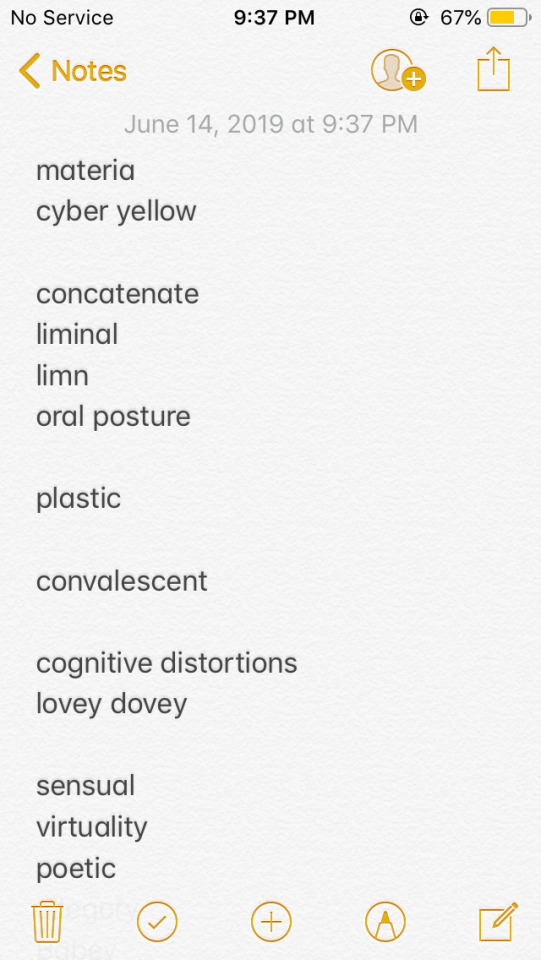
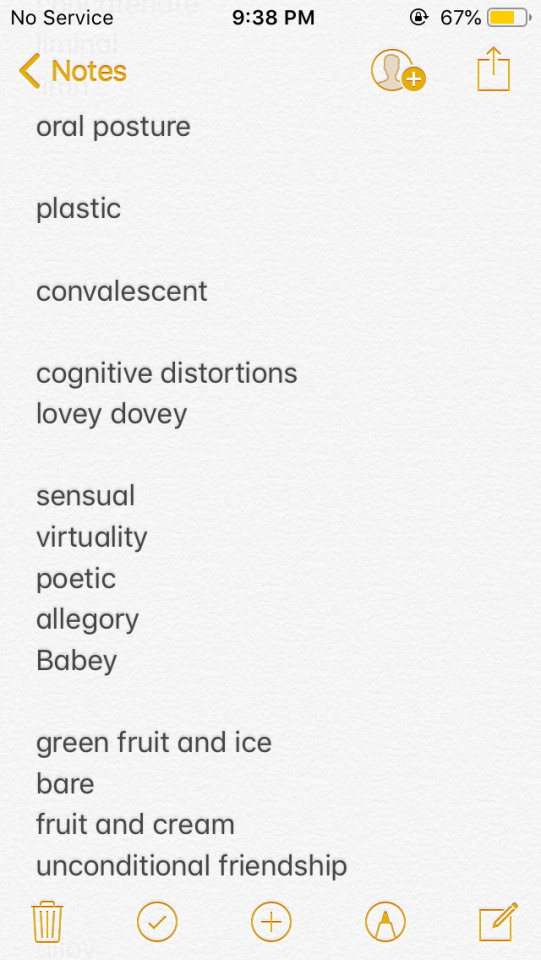
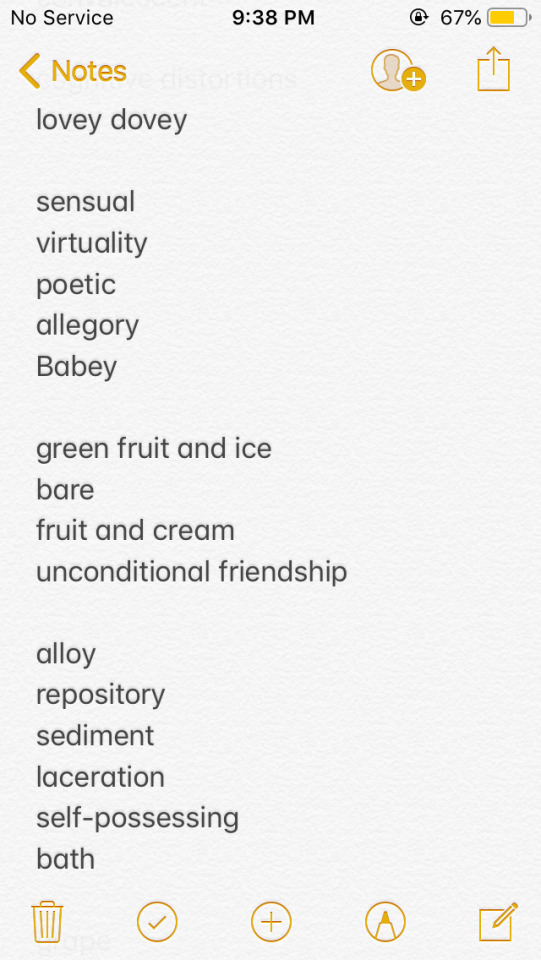
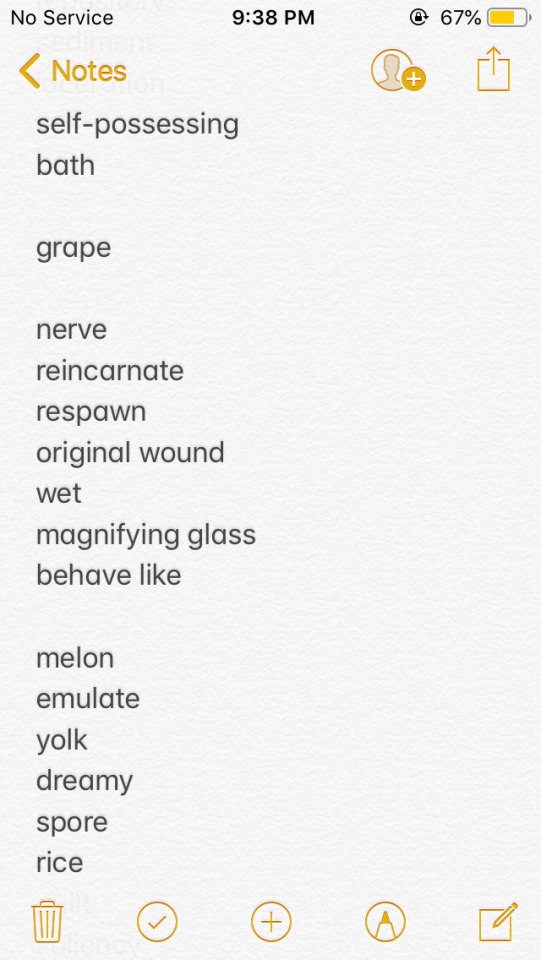
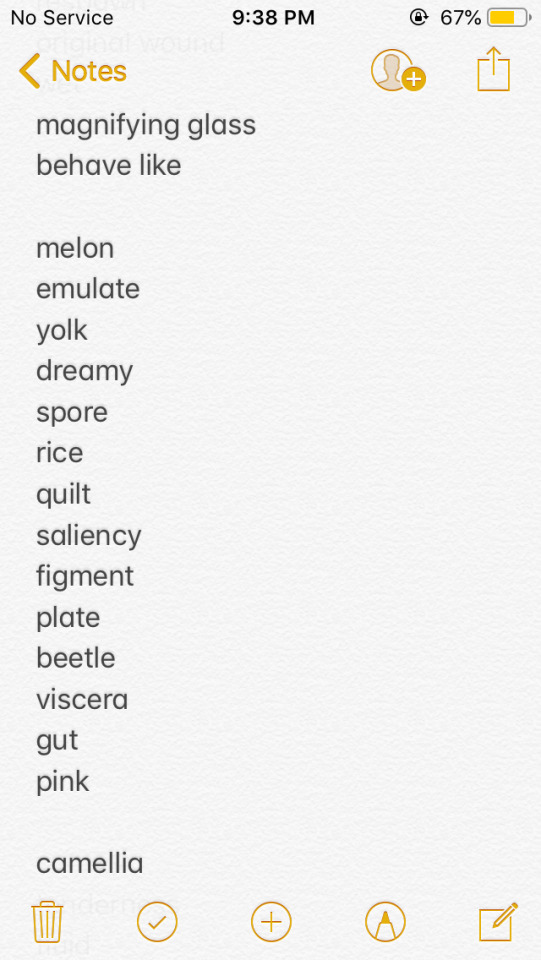
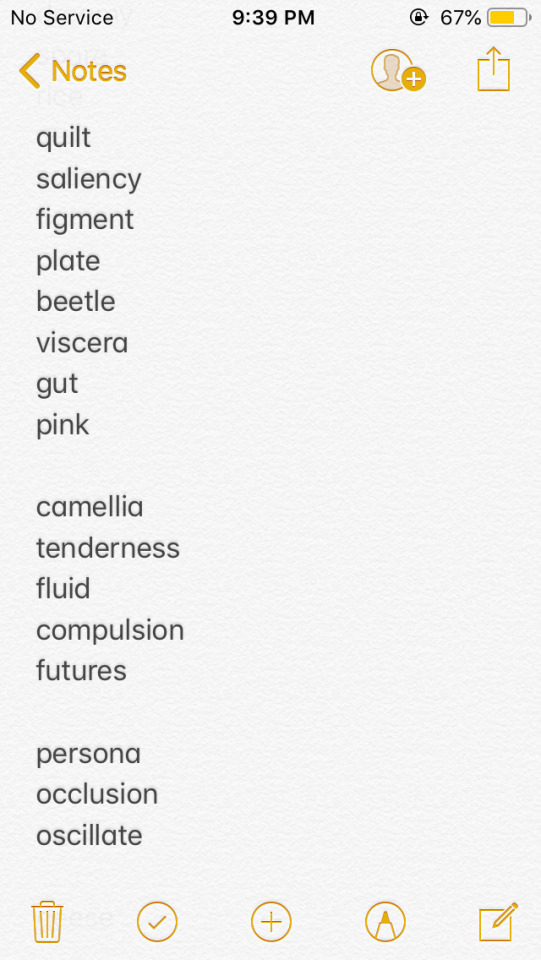
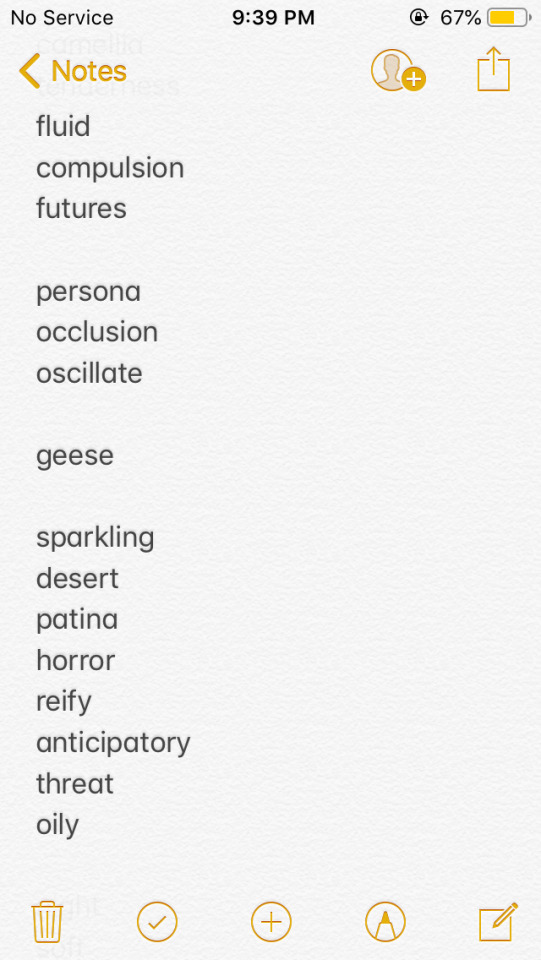
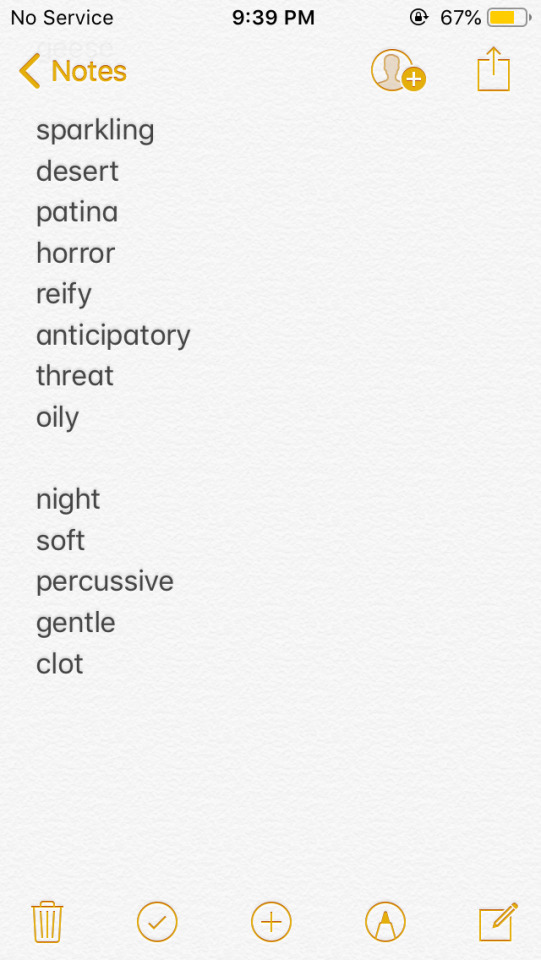
materia, 2018-2019
I don’t get a lot of time to read on my commute from my home near the university to downtown. Many of my colleagues have a long commute on which they read their books (which we go over in our work book club, something I really love to listen to. My commute is chopped up and I spent a lot of time going up and down stairs or weaving between people.
My return commute is longer (an hour or more) and much less hurried, and late night buses are infrequent. While I’m waiting for a bus or a train, I sometimes add to a body of my favorite words, or word sounds, ordered and spaced according to how I want them to sound together in this concatenation. It’s calming and feels like a puzzle, or the last stretch of editing an essay or a letter when you want to communicate something very subjective with the most specificity (also subjective). It feels satisfying, healthy, and sharpening.
I first shared this on my Instagram stories in June. I had taken the train in the wrong direction, had to get out and run to the other platform, and wait about fifteen minutes in the tunnel. I rearranged some things before taking screenshots - I was planning on getting a new phone soon, and wasn’t sure if my notes would make it because I never back it up, and the visual references felt genuine and I want to be more in the habit of allowing the small creative habits I’m trying to maintain to carry the same importance I used to reserve only for painting. It seemed to resonate with my friends, which was nice, since it feels like sharing a very private artifact but knowing that they found it pleasant to read too was a pleasure. Pleasant.
The first word is from the title of a publication by Japanese photographer Rinko Kawauchi. I love her work, but I’m unsure in what form “Materia” actually exists because I saw the cover from a Tumblr post, the same way I discovered her body of work, and it’s not on her website.
I first heard the word “materia” as the Final Fantasy term for powers/abilities/knowledge. Of course that’s just been a point of departure for developing a difference sense of the word, but I think of that first.
Certain other words on the list come from internet searches, articles, jargon that you hear a lot in exhibition titles and the smattering of graduate degrees dealing with digital or new media art in some way (a degree in “digital futures,” ... also things like Speculative Ecologies or Poetic Computation) . And other words used to talk about symbols or gestures in modern painting, popular in writing probably from the 60s through the 80s, in reference to Rauschenberg or Gorky (reify, oscillate, allegory). Some are from video games. Some are food items, usually in a mental image of in that vibrant, highly saturated hue of a dye transfer print because produce is aesthetically beautiful, sculptural and totally mundane and poetic. On its own. There is a lot of labor that goes into farming industry and marketing produce to put the melon on the stand, which is not what I always think of when I get the melon out of season and out of the region where I live. The melon is also the rectangular prism of the Melona ice cream. Green fruit and ice is editorial. Rice is nostalgic.
A lot of them are words I use to describe my feelings in therapy. Sediment, threat, compulsion, self-possessing, though these are all terms that can be applied to artwork as well. I like that they are aspirational, in terms of how I want to be, and critical of how I feel. And not all of them have singular images or meanings. They belong under materia for that. There are more lists in materia, but these make the most sense together.
I know this blog was created for class, and I intend to keep adding excerpts from books, articles, texts relevant to embodiment, landscape, technology and perception, and navigation. materia is an organized reminder of recurring themes (visual motifs, aural motifs, tangential to embodiment or perception or memory), and I’ve been reading too many good things to not try to connect them back to one another - in my conversations, in small moments of video that remind me of those themes, in game tropes or mechanics or emulations, or poetic writing - using links, tags, and a platform that allows reblogging, or easier appropriation of those images and the chain of provenance. I’m aiming for something essayistic, something like an index for that reading, a database for things I forget and then remember and forget. I kind of hate that Facebook allows you to remember people you could have forgotten happened to you, and how it prolongs some acquaintanceships/connections/relationships longer than is natural for the memory. I know a lot of things that aren’t my business, and that those things show up on my internet activity alongside things that I forget too quickly.
It’s a repository for sediment and it’s not that deep but it’s more visible and more connected than separated by written pages or filed away, so thanks
4 notes
·
View notes
Text
Royal Nightshade's Influence Map (Part 1)
Hi again! This is Volt and we're back with another blog post! This time we want to chat a little about the artists and themes that inspire us; what makes "Royal Nightshade"? KingRhapsody and I want to share what we love. This is part 1 of 2!
Volt's Influence Map

I'll admit, my influence map is a little all over the place, and there's a lot that I actually don't have on here- I wanted to really work my brain for the themes and artists that recur or that I constantly refer back to, so that meant not just reaching for a bunch of Disney or anime from my childhood and calling it done (Not that there is anything wrong with that).
More below the cut!
Artists
JC Leyendecker: (Top left) One my my current inspirations and has been for quite some years now. I learned about him and the way that he made art. He led quite the fascinating life. Some of my favorites of his are on that map, I love his finished advertisements and works for the Saturday Evening Post just as much as the quick studies he did. There is something timeless about his art that I love that I find to be the opposite of Rockwell's, which tends to lean very 'Americana' and 'Of That Time'.
A lot of the visual cues I try to implement from him are the sculptural brush strokes, as well as the very confident air about the characters he draws. There is something very statuesque about his work, and yet it isn't stiff or lifeless. He has a unique design sensibility that I really like. A lot of his work is quite like Art Deco, which I love in architecture.
John William Waterhouse: (Top Middle) I absolutely love his color mixing and his theming of powerful women and scenes from mythology. His work is looser and more ethereal than Leyendecker's. I find the running theme to be strong silhouettes and good contrasting and saturated colors. There isn't much else I actually have to say about him, except that I like to do master studies of his work every so often.
Frederic Leighton: (Lower Left) If you hadn't noticed, I love painters who create within the themes of classical art or mythology (more on that later). But Frederic here is actually one of my favorites specifically because of that. his colors and light are masterful, and I'd love to create powerful scenes like the one on the map of Hermes returning Persephone to Demeter.
Modern Media
I don't want to spend too much time here, because there's more modern media than I have room to cover. Needless to say, I grew up with toonami and Super Nintendo. So I chose some games and an anime that best suited what I feel represents a good deal of my influence from those things. Notable mentions are
Yu Yu Hakusho, a shounen anime you should watch if you haven't already, and definitely an influence on the way I approach characterization. If I had to tell you an example of what my favorite style is for 90s anime, I'd point you here, or to Cowboy Bebop.
Chrono Trigger is definitely a part of my formative years as a baby gamer. I took pretty well to fighting games, and I could sit here all day and talk to you about how much I love King of Fighters, but Chrono Trigger sums up what the vibes are when it comes to non-linear narrative, which is definitely what my comic is shooting for, but not in a time travel way directly. This game makes you think about the consequences of actions you can and cannot control in the flow of history.
And the music slaps.
Seiken Densetsu 3- Oh, I'm Sorry, Trials of Mana, was a game I played many times on an SNES emulator, fan translated. The characters and the various adventures you went on really inspired me! The colors in this game are so rich and I liked all the different locations and monsters. It makes me want to expand on the lore of the world in which Royal Nightshade exists. King has played this one too and he thoroughly enjoyed it!
My favorite characters are Kevin, (but then again I love werewolves) and Angela (because she shares my name and has cool magic, sort of a brat though). Please play it! The remake is not bad, but the original is great. Music also slaps, but not as hard as Chrono Trigger to be Honest.
Themes
And finally, I'm sure you've noticed peppered throughout the map is Hermes, who is honestly The Best. God of commerce, travel, boundaries and communication. I love him so much. Here at Royal Nightshade we stan a busy god.
In general, you'll see themes of mythology (Greek in particular although I love all sorts), as well as liminal spaces, fantasy and alchemy; the latter one is a big influence to me, given that the main character of my comic is an alchemist. I don't know. I love the symbolism, the theories, the philosophy, it's so easy and fun to make up themes within the umbrella of alchemy because it was so based in belief and what many early practitioners thought was the way to back up their theories.
I love mixing fantasy into reality in those ways and playing at the boundaries of science and magic. King tells me I'm really into 'science fantasy' themes, and I guess it hadn't occurred to me until he mentioned it.
This was a great exercise in exploring what I'll be bringing to the table here at Royal Nightshade! You can expect a little bit of everything from those inspirations.
1 note
·
View note
Text
Week 9 | Work in Progress Presentations

PROCESS + REFLECTION
This week Laura and I couldn't make class due to sickness and to be completely honest; deficiency of time management on my part. We have been behind the weekly schedule and have not had any progression for our proposal since week 8. So I took this opportunity to return to the site to strengthen our conceptual basis for the work.
I wanted to return to the site on my own, I have a habit of avoidance of attendance when it comes to class because I generally like thinking and working on my own. I wanted to experience the site solo as I felt I might connect to country better.
I took more photos of the site and reflected on our idea to do a hanging installation. Site one doesn't have many trees but it does champion many great flat spots overlooking the view, it would be a shame not to utilise this. I think we need to work with our site rather than against it. Nothing beats that view and I can't get it out of my mind do create something that interacts with that. There is a decent amount of wind up the top of the hill. This suits a kinetic sculpture. I'm leaning towards a pinwheel mechanism over a hanging structure and will have to discuss this with Laura.
In my research I looked at the Victoria Park history document and lectures 7.1 through to 7.3. Throughout conversations of what Barrambin used to be and what the Council is trying to recover, I found the most recurring theme the lost waterways. I drew shapes based off early maps of waterways found in the Victoria Park Summary (Kerkhove, 2020) from the BB learning materials. Creating something wind activated that focuses on the sites relationship to waterway is the path my research is leading me down. I also found out that the Brisbane river used to clear and swimmable, vastly different to the chocolate milk colour it is today. This has an adjacent dialect to the evolving ecological landscape of Barrambin and the greater Brisbane area happening today. This concept has much more breadth and depth of research, I actually feel like I've learnt something.
DOCUMENTATION



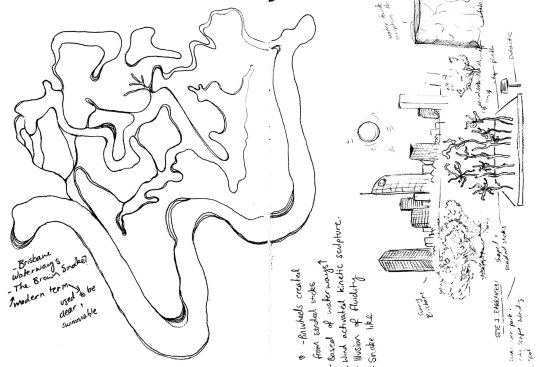




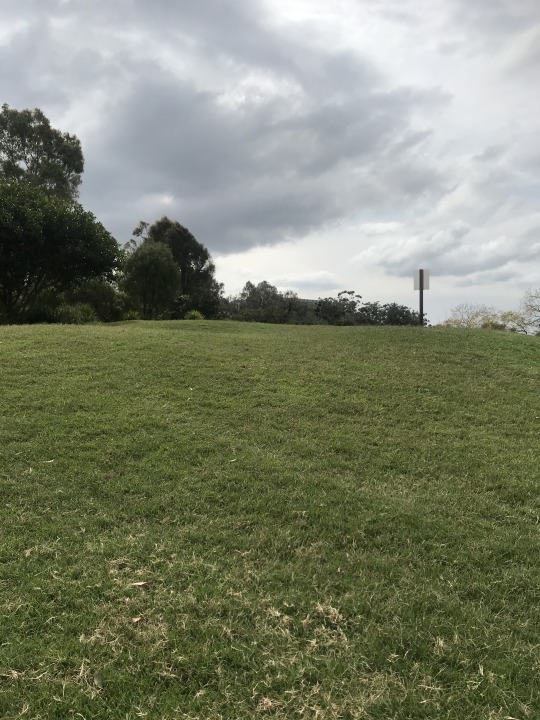
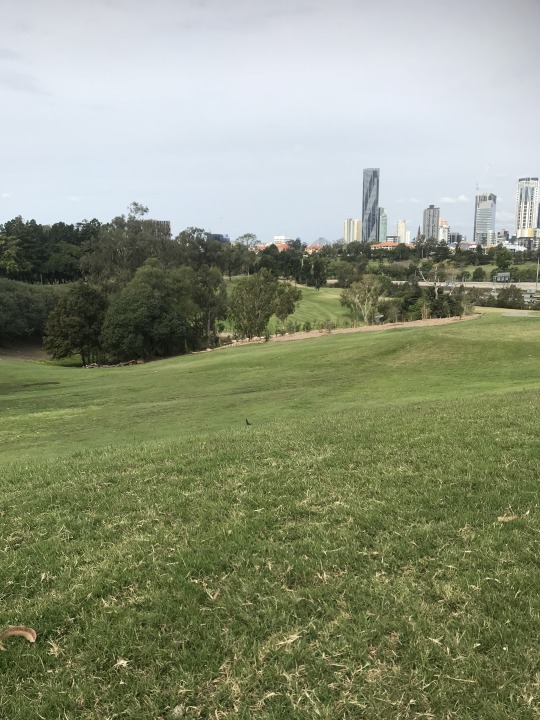



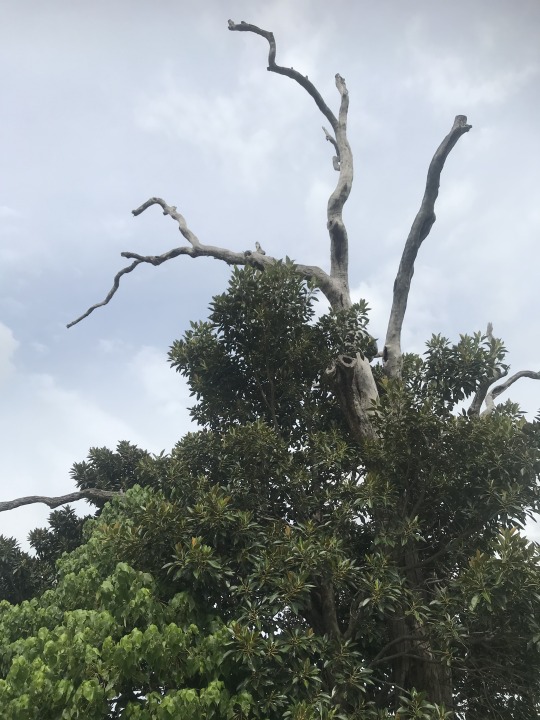

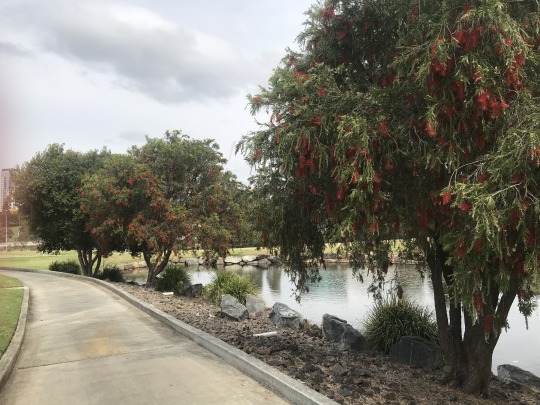


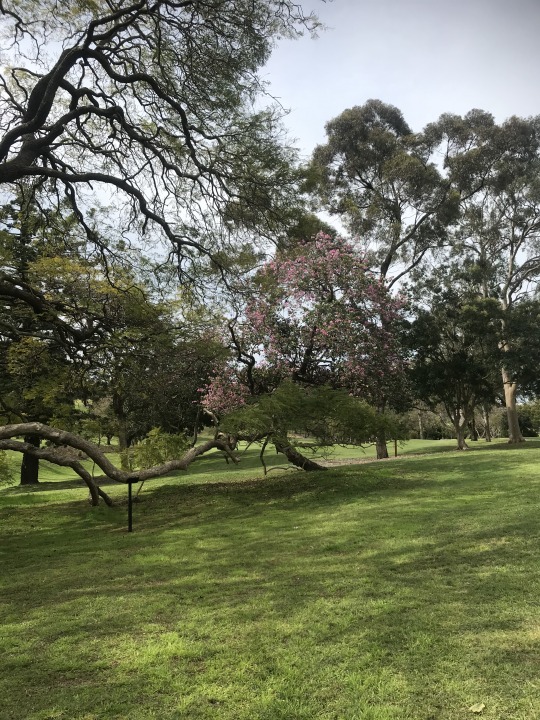
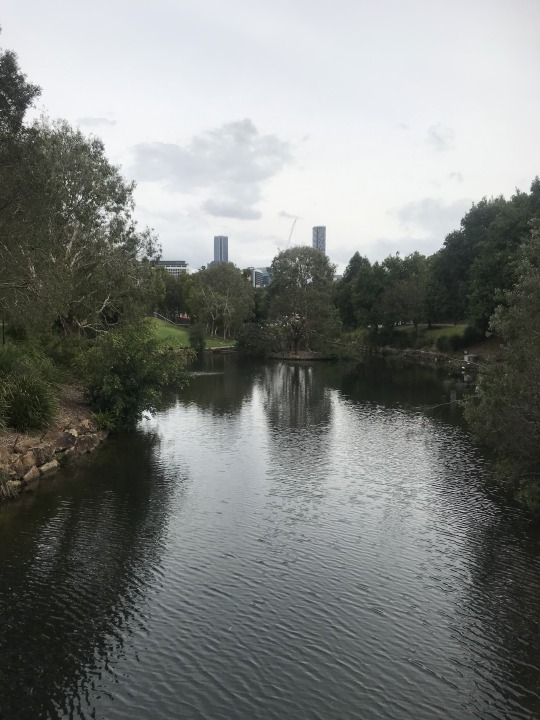

RESEARCH

Goldworthy, A. (1986). Woven Branch Arch [ephemeral branch sculpture]. Langholm, Dumfriesshire, Scotland. https://www.pinterest.com.au/pin/354658539376150080/
ANDY GOLDSWORTHY
Andy Goldsworthy is English artist most known for his ephemeral site specific land art, where he takes materials from the site and leaves the work to be reclaimed by nature (Newcastle Art, n. d). Goldsworthy's practice is broad and driven by the properties of the site, integrating with it rather than imposing on it. Goldworthy's material choices reflect what Laura and I would like for our own proposal. Barrambin offers sticks, leaves, timber and bamboo however our challenge will be our lack of knowledge for the naturalistic materials.

Gallaccio, A. (1991-2003). Preserve Beauty [large scale flower and glass panel installation]. Lehmann Maupin Gallery, New York, USA. https://www.tate.org.uk/art/artworks/gallaccio-preserve-beauty-t11829
ANYA GALLACCIO
Anya Gallaccio much like Goldworthy creates site specific installations using organic matter, however focuses on the process of decay of these materials in the gallery context (Douglas, 2018). Her work Preserve Beauty (1991-2003) is a large scale installation that showcases red 'beauty' flowers, hung behind 4 large glass panels and were left to decompose in the gallery. This work references traditionally feminine flower arranging practices while commenting on the fleeting and commodified nature of beauty (Anderson, 2014). I admire the way Gallaccio uses simple organic materials with such symbolic intention. This inspires me to conceptualise a work that has careful symbolic correlations to material and/or site.
REFERENCES
R, Kerkhove. (2020). KVB222: Spatial Art: Object & Site. Victoria Park Summary. https://blackboard.qut.edu.au/bbcswebdav/pid-10116741-dt-content-rid-58666643_1/courses/KVB222_22se2/Victoria%20Park%20Area%20Summary.pdf
0 notes
Text
Paraphrasing pop art from art toys movement
We think that Art Toys Movement has been built upon the “paraphrase of Pop Art”, although now the myths for designers and artists are others. And when we talk about others, we talk about characters like Mickey Mouse, an icon that is really known throughout the world. For whom many feel – and express- an authentic kind of personal passion and enthusiasm without limits making him the charismatic character he is nowadays.
A period of time, this, when the impact of contemporary technology and its influence in our perception and in the possibilities of paraphrasing the icons are even greater that in the late fifties in USA and early sixties in Europe when Pop Art was born as an artistic current.
Mickey Mouse ... charismatic character that almost everyone - literally - knows because have heard about him, or has seen and read about him and his adventures since 1928 when he was born as a protagonist of animation. And that today is considered an iconic character that again and again becomes a trend, or in truth, never ceases to be. In many and very different ways. And for different types of artists and professionals.
As for many artists and designers within the artistic Trend of the Art Toys, that with all their influences, from the most pop, urban, punk style to the most surreal, ethnic, fantasy, terror, gothic, kawaii, conceptual, naive, expressionist, figurative, realistic, subversive or lowbrow, and regardless of the age of the artists and their origin, one of their recurring themes have been, and are, usually, myths of their youth, like Mickey Mouse character, that as soon as you see his silhouette you recognize.
An artistic Movement where the artists "take" the character and impose their own sensibility, paraphrasing the character themselves. Or what is the same, starting from the consideration of what the creator wanted to tell, add new reflections, those of their own look. With the pretense that afterwards in time the public and the collectors when they have that artwork in their hands also have the possibility, if they want, to interact with them, creating their own scenarios and atmospheres. Because as we say: Art Toys: More than Dis(play).
And the artists paraphrase them in the sense that being very close to the original concepts, with their own hands, they create a new artwork by giving an obvious credit to the iconic work of art. Telling their own story. Talking about themselves and their influences. Engaging a unique connection with their target public, an audience to those who show themselves as they are…regardless of where these collectors live, where in the world they are.
Nevertheless, and as we have already told at other times, when this artistic Movement of the Art Toys began to "discover" itself, we speak of an era, in the mid-nineties of the last century, in which globalization is in full “boom”, the same as the consumer culture. Time in which there is a process of clear hybridization of cultures, between the West and the East, and in which there is a great mobility of cultural products because there are fewer limitations and borders, besides that we have Internet and Social Networks. And we easily reach to all kind of public. Collectors and other professionals with whom to work.
And we are talking about a Movement or artistic Trend that although it finds its roots in Tokyo and Hong Kong, today it is already part of something culturally much bigger globally. And also more diverse and heterogeneous than in its origins.
Society is increasingly multicultural, there is a great interrelation and interaction between different countries, and at a certain moment, it is when it seems that a new kind of cultural creation begins to arrive at the market thanks to the impulse of creative people, who create and promote an art form that refers to a new language and new form of communication and contemporary artistic-plastic expression. To new forms of design and of creation, a mixture of art and toys. And that the artists themselves promote by their own means and often with the help and support of other professionals who have the same cultural references as these artists, and who bet on their work and support them in their discovery possibilities...
Artists like Coté Escrivá.
Born in Valencia, Spain, on May 22, 1982. He is one of those artists, designer and illustrator, who over the years has been creating his own personal universe from an aesthetic influenced by popular culture. An artist that has managed to bring those comics and animation series that have accompanied us throughout our lives to his own imagination, adding other influences and references coming from Pop Art, oriental and underground culture, graffiti and Street art, the tattoo art or the lowbrow or pop surrealist style.
Resulting in disparate projects, a kind of drawings, illustrations within sinister and tender or friendly, as some people say; with an aesthetic that is also provocative and burlesque. Some of them from icons of pop culture assimilated by Coté Escivá, reinterpreted, giving rise to different hybrid creations, between artistic and commercial, with characters that are familiar to all of us. Characters that are born from sketches in paper and pencil, and then are worked digitally with a graphic tablet.. Exploring the popular culture through surprising "series of mashups" of mass-public visual icons that everyone knows.
Thereby, giving rise to a type of sculptures, Art Toys, like those that the Thunder Mates brand from Hong Kong is helping to give life since this past year 2017, working on some of Coté's most iconic characters.
A mix of art, graphic design and original toys, collectible and aimed at an adult audience as Woodrow Phoenix would say
"Plastic Culture" (2006). Pieces that combine a bit of tenderness but also a high degree of ambiguity or blackness as Paul Budnitz, founder of Kidrobot, wrote when referring to the Art Toys in "I am Plastic, too" (2010).
And in the case of Coté with his artworks, in addition, we see the interior of the artist in a non-subjective way. On the contrary, he shows himself starkly inside. And inside, what can we find but bones and other viscera and elements? It´s a forthright work, merciless in a certain sense ... Artists like Coté are as if they showed their deepest, intense and heartbreaking insights, but doing it without detours or subtleties. It's as if these artists said, “I'm going to split the toy with which I've grown, interacted, and you're going to see the inside of it”…
When an artist uses a toy as a creative platform he/she is an artist who does not want to shy away from childhood. We are what we have grown and lived, and what we have been taught. We are not born with the age we now have. We have been learning and when we are children, playing is learning. And if we say that we have studied one thing or another for a specific purpose, why are we going to leave behind those drawings with which we have learned many of our values, ways of showing ourselves and certain likes, and even the way of seeing the world? Things that make us what we are...
And in the Art Toys of Coté there is always a part in which the inside of the Art Toy can be seen. We all think that toys are hollow and yet there is a character who suffers, who lives, who has a skeleton and viscera. And Coté shows it to us.
People at our age, when they see a toy, see something inanimate, that only when a child plays with it can it come alive. But the artists who make Art Toys see a part of themselves. And that's what Coté wants to show the spectator. Through that toy that twists he shows his interior. And his own inner self is loaded with images, memories, some more raw than others. Because toys are part of our memories. And we are all made up of memories that make us what we are. And the childhood of most of us is loaded with toys, comics, and all kinds of pots ... And artists like Coté what they do is bring that toy from their childhood but loaded with everything that is now as an adult. Of what he has lived.
People usually stay with the outer appearance of the toy. But look further! The toy is something else, it's life, the toy is what made you what you are. They are not something inert or silly or childish. That's why artists like Coté seek with their Art Toys that people see and discover that in reality we are that toy but with scars, with the spanks that life gives us. And in this task is Coté when he works with recognized brands such as Thunder Mates.
From a dynamic collaboration, with an open mind. Sign of our times. Where barriers do not exist, only those that we can put ourselves. And addressing a non-conformist type of collector, who does not like what is normally established. With a kind of close and not boring creations. Testubg the power of the cultural and social conventions of the spectator, demanding a reflective, mature look to the collector. Because otherwise, it would be just a Toy. And here we are talking about Art Toys. A type of work that "imitates" life, which is a reflection of the experiences of the artists and also of what surrounds them - from the cultural, social point of view...
Art Toy Maison (Cristina A. del Chicca y Sergio Pampliega Campo)
www.behance.com/arttoymaison
http://arttoystheoryandcriticism.tumblr.com/_
Co-Founder Members of international artistic Collective ART TOY GAMA
This text was originally written in Spanish and translated into English for us (although in this case the text is not exact), so that the text can have grammatical errors, so we apologize

#Art Toys#designer toy movement#cote escriva#resin art#resin toy#mickey mouse#disney#pop art#thunder mates#creepy mouse
3 notes
·
View notes
Text

Bench No. 3 by Floris Wubben really stood out to me as I was gathering lots of pictures for an inspiration collage. At first I only saw the polypropylene on top, which I originally thought was paper. It gives off such an accordion look which was really visually interesting. The way it’s described in the article above is like decorative icing or ribbon like, which after reading that I can agree with. The drift wood underneath somehow appeared so subtle to me, which is what made me really consider a concept like this for my cushion, because if it can blend in this naturally on a white background, it will blend in even more perfectly on a natural background in Albert park.
Floris Wubben is based on Amsterdam, and focuses on the intersection of functional and sculpture design, which really shows through int heir projects. Nature is also a recurring theme for them, which makes me interested in researching more of their projects for inspiration for my cushion. Something else that stood out to me is that they use low tech machines to make their projects, which makes me hopeful that I should be able to create a similar effect (should I choose to) in my cushions with the tech available to me. https://floriswubben.com/about/
0 notes